#interestingly chronologically
Explore tagged Tumblr posts
Text

In true spirit of anarchy I pressed the wrong button
What about Terry Toadstool the cinema owner/Mr Bean the postman from Dirty Movie - even if they’re not a comedy duo they are the yin and yang of this episode?
kinsey scale but for rik and ade fans - between the two characters in their duo acts (richard dangerous/sir adrian dangerous, rick/vyvyan, kevin/keith, dreamytime escorts, richie rich/eddie catflap, colin/vim, richard richard/eddie hitler, richard twat/eddie ndingombaba, any i'm forgetting) who usually played your favorite (and yes pls reply with all your Thoughts if you want!!)
#interestingly chronologically#it’s pretty equal between the dangerous brothers#rick and vyvyan#vim is a sympathetic protagonist even if he is laughably deluded#but colin is funnier#by the time we get to richie and eddie#eddie is almost normal#just drunk violent and occasionally surreal#richie is more vulnerable#more utterly bonkers#more split between earnest dork#and slimy creep#adrian’s characters can look after themselves#rik’s can’t help opening their mouths at the wrong time#adrian’s usually know when to put the boundary wall up#rik’s don’t know that there is a boundary wall#that’s what pulls you in#we’re all afraid of being that exposed#we all know how stupid it is to be that exposed#adrian can do innocent#but he doesn’t go to that vulnerable place#except with vim who really wants to be in a famous band#thinky thoughts
11 notes
·
View notes
Text
#tumblr#to be clear. I am not doing this lol#but I was thinking about how encountering posts in reverse chronological order is really core to our shared experience of being on this sit#so how would you translate that experience in physical media?#of course that act of translation would be interestingly fraught and flawed for all sorts of reasons lol#and one of the big decisions you'd have to make would be how to arrange everything!#is the 'reverseness' absolutely key even in a new medium?#or is it just a necessary byproduct of our insistence on keeping everything in *some* kind of chronological order?#or a necessary byproduct that we've come to know and love?#or a secret fourth thing?
2 notes
·
View notes
Text
A little speculation about Corpse Disposal and J-horror
But I'm a little bored so sharing a part-theory, part-headcanon on Muu and Rei
So we unfortunately don't see much of Rei in "Its not my fault" but I want to point out three key times we do
The first time we see Rei in the MV, is her wet sleeve (we know its not Muu because Muu wears a pink jumper under her blazer)
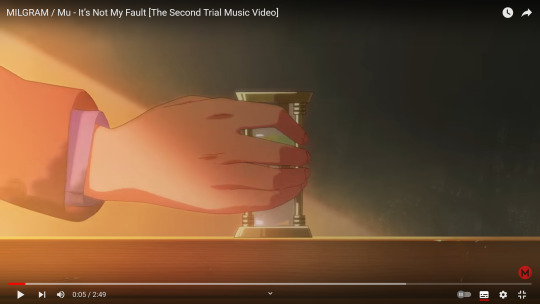
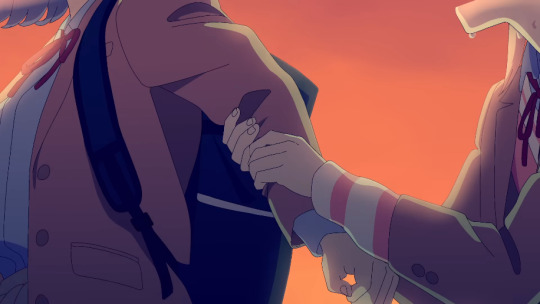
Then, after a lot of bug stuff, we're finally back in the real world, where Muu has just killed her Post-After Pain. In INMF, we don't see the surroundings as well, just the dirt track and bushes. But in AP, we see this is right next to a rushing river (Muu's undercover card also features a bridge as a landmark)
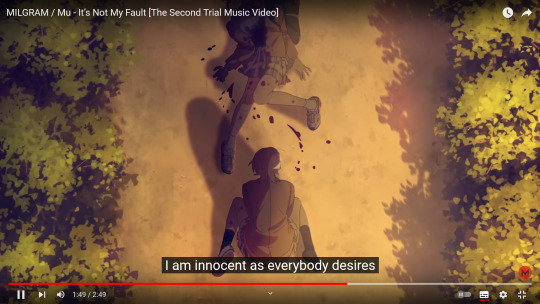
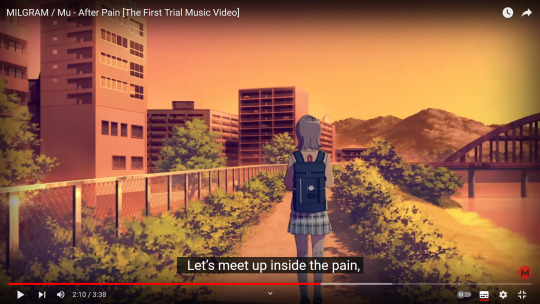
The next time we see Rei after her corpse, is a flashback to the start where she turns the hourglass over. Then it cuts just further back to before Rei stood up - as she pulls herself up off the floor She's alive and absolutely soaked after a session of intense bullying (which we saw Muu insert herself into in AP)
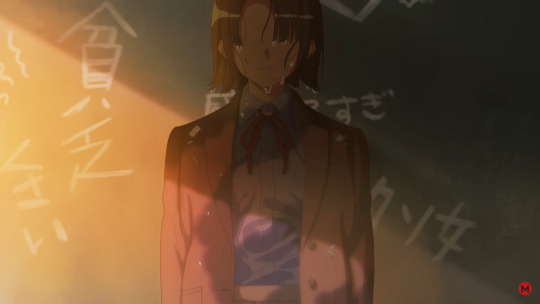
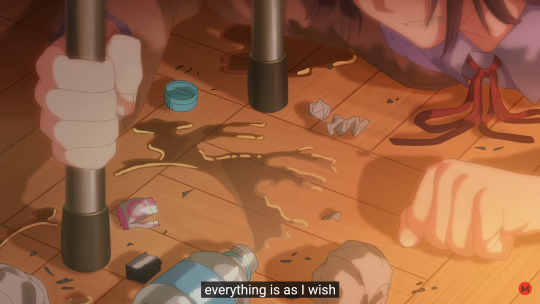
However, I want to now switch a little to talk about cinematography and a concept called the Kuleshov effect The video I linked is pretty concise but the gist is that if you put two shots next to each other, even if they were filmed separately, the brain interprets it as a continuous scene (so if you film a character looking off screen, then a picture of an apple on a table, we're going to assume they're looking at the apple)
Therefore while we understand chronologically that the sequence of events is Rei (wet and alive) -> Rei's murder on dry land ↺ Flashback to Rei still wet and alive Which I think everyone understood as a commentary on how this power struggle was a constant cycle of the hourglass being turned over
I think visually, it also implies a sequence like Rei was bullied -> Muu kills her -> Sopping wet, Rei crawls back to the classroom
But wait! That sequence suggests a missing step How did Rei get wet again?
Well, we know Muu killed her next to a river And if you were a scrawny teenage murderer with a body on your hands, would you leave it there where someone could see it while you grab a shovel and stand in broad daylight digging a hole in tough ground??? Or try lighting a fire in public??? Of course not!
It'd be much easier for Muu to, in a panic, just roll her body into the convenient river and let all the evidence wash away!
(Of course, if Muu was panicking, she might not have been very careful. Given she ended up in MILGRAM, there must've been something tying Muu to Rei's death and in T2 Muu seems to have finally remembered losing her left shoe...)
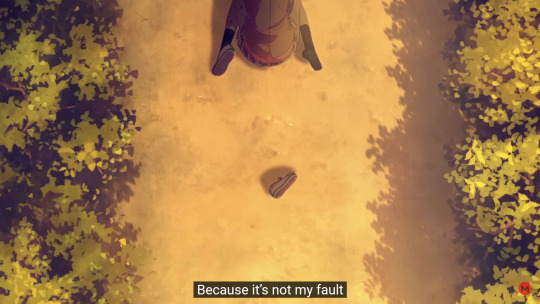
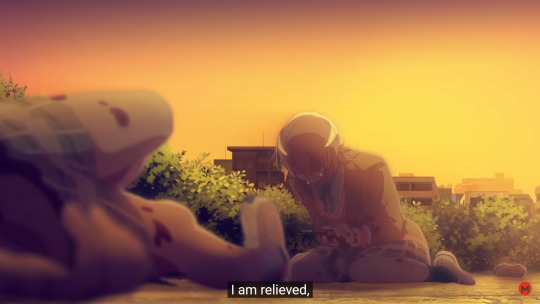
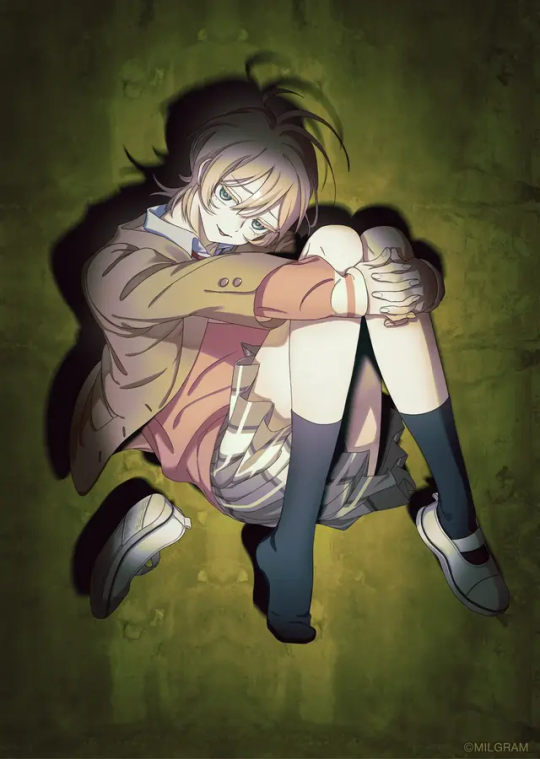
Fun fact: this is the same shoe Cinderella loses in the animated Disney film (and the best known version of that story came into English from France)
Shoe break over, back to the Endless Queen's Game
So, if we assume Rei's corpse was thrown in the river, what does it matter? Its just a pointless headcanon
But I speculate the meaning goes deeper!
So that image of Rei, soaking wet, crawling off the floor reminded me of something: J-horror ghost girls! Specifically the most famous of ghost girls Samara/Sadako Who became a vengeful spirit after being thrown in a well and now crawls out of TVs to kill people who watched her VHS tape
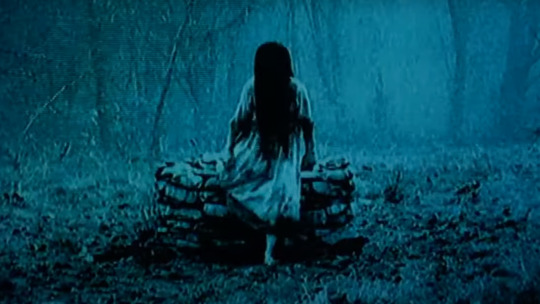
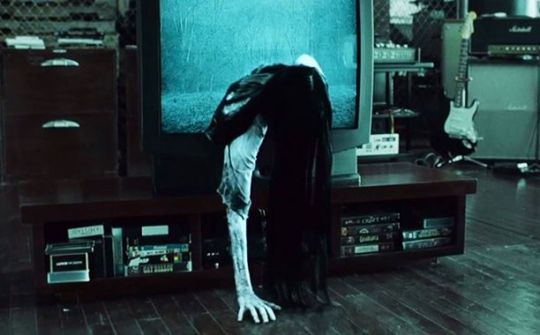
Her story too is a cyclical one (its called 'Ring' for a reason), the only way to break the curse is to copy the tape and have someone else watch it, who will then become the victim unless they can themselves copy the tape and show it to another unsuspecting patsy
The story goes back further because this movie is based on a novel, which is based on the legend of 番町皿屋敷 Banchou Sara Yashiki. There are many versions but generally a maid girl Okiku is proposed to, and when she rejects the proposal, her master breaks one of ten plates and promises to forgive her if she marries him. When she declines again, he beats her to near death then throws her into a well (sometimes it's a jealous mistress instead of a master)
Interestingly, Atrophaneura alcinous (swallowtail butterfly) larvae found in Japanese wells became known as Okikumushi お菊虫 (Okiku bugs), tying back to the whole insect thing...
It's been said a bunch now, but the name 'Rei' can be read as 霊 meaning ghost (seen in words like Yuurei 幽霊, a more common word for ghost than Rei on its own)
We know Muu is afraid of ghosts too (though I must admit she says Obake, not yuurei, but both words refer to ghosts)
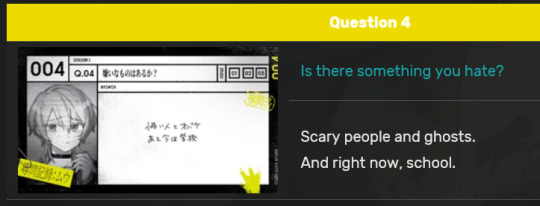
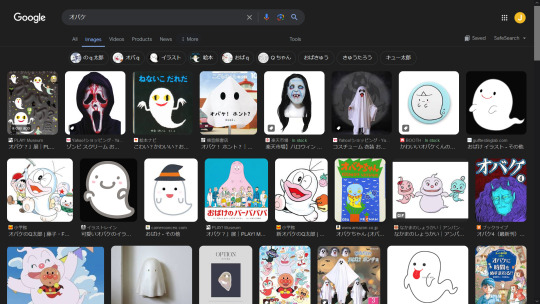
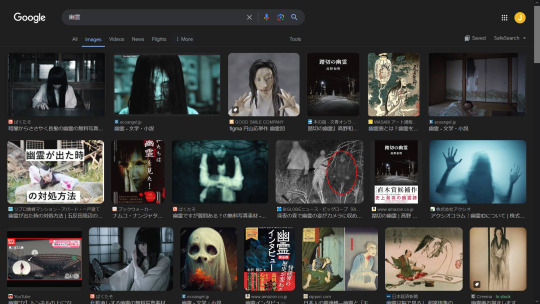
Remembers the i/井 in Sakurai/櫻井 can be read as 'well' I'm sure that has nothing to do with anything
Uh, I can't think of a conclusion because its 1 am and I had to look up a bunch of spooky images
TL;DR: I think Muu may have quickly shoved Rei's body into the river next to where the murder happened (maybe forgot her shoe at the scene of the crime) and now she's scared by the cycle continuing and Rei coming back to haunt her
#muu kusunoki#rei milgram#haruka sakurai#milgram#ミルグラム#milgram theory#I can't fit it in the post but isnt it funny how Rei and Muu's lives revolve around cycles#then Rei dies of blood loss after a sharp pain in her abdomen
294 notes
·
View notes
Text
Okay, this post has been a long time coming.
Basically, there is a huge amount of misconceptions about liujiu and their history, and it's very frustrating to see in arguments about canon, so. I'm here to clear Liu-shidi's reputation and browbeat SJ with a newspaper (affectionate).
There is a whooping total of 4 liujiu interaction scenes in SVSSS. In chronological order:
The first meeting occurs at an inter-peak competition, where SJ hates LQG at first glance. LQG wins a sparring and has an air of "matter-of-fact arrogance" about him, which only strengthens SJ's dislike. What's interesting is that next SJ ambushes LQG after the sparring and "uses every means" to attack him, as recounted by Yue Qingyuan. Which does nothing to endear SJ to LQG and makes LQG very understandaby wary of SJ.
The second meeting occurs in a brothel. Backstory: SJ stumbles upon a Baizhan disciple named Ji Jue on the street, they have a quarrel, SJ beats and seriously injures Ji Jue, then goes to a brothel. LQG hears about it and rushes to "teach SJ a lesson". Interestingly, nowhere in the text is it mentioned that SJ is injured in any way after his scuffle with LQG, even though the fight has apparently taken quite a while and LQG is a way better fighter than SJ.
The well mission. SJ, LQG and SQH are assigned to deal with some evil spirits in a remote village. Spirits fly out of an old well, one of them attempts to attack LQG from behind, SJ sees it and attacks the spirit, but accidentally brushes over LQG's shoulder, which LQG mistakes for an attempt to kill him. SQH tries to clear the misunderstanding, but SJ threatens him into silence. Again, LQG and SJ come to blows, but no injuries are mentioned.
The disciple acceptance ceremony. SJ and YQY are watching the potential recruits, LQG arrives, has a brief but civil conversation with YQY, SJ intervenes, LQG insults him and leaves.
That's it, folks! That's literally every liujiu interaction in canon! Now with this out of the way, let me disprove some of those fanons I see in liujiu fics every damn time I dare to open one.
LQG did not mistakenly believe SJ to be a son of a wealthy family. Nowhere in the book does LQG ever comment on SJ's origin. This is a fanon from "The Grand Unified Theory of Shen Qingqiu", which is a great fic, don't get me wrong, but god did it mess with people's perception!
In the same vein, LQG never accused SJ of being lazy. Ever. That was QQQ.
LQG wasn't unreasonable to immediately assume SJ was trying to kill him during the well assignment. Think of what LQG knows about SJ at this point: SJ is willing to ambush someone because of entirely stupid and petty reasons like a lost sparring; SJ is perfectly willing to seriously injure his fellow disciple (see: Ji Jue); SJ is constantly threatening to kill LQG (mentioned in the brothel scene); SJ is not above using dirty tricks to achieve his ends. Yes, the suspicion made SJ feel bad, which is perfectly understandable (poor SJ was just trying to help!), but it wasn't entirely baseless. LQG's conclusion was based on SJ's prior behavior.
Speaking of SJ's dirty tricks: no, when people mentioned SJ's penchant for dishonest means, they weren't talking about harmless tricks like qiankun buttons. SQH insinuates in canon that SJ wouldn't be above shanking LQG with a poisoned knife in the middle of a sparring (Airplane extra, when he watches LQG spar with SY!SQQ), and Ji Jue, someone who's fought SJ personally, seems to agree.
LQG did not condemn SJ's womanizing and/or his visits to the brothel. The only times when LQG comments on SQQ's private life in canon have to do with LBH and bingqiu. To put it simply: LQG did not give a damn about SJ allegedly spending time with sex workers. Nor did LQG constantly stalk SJ to try and catch him in a brothel. Nor did LQG ever lecture SJ about sex being bad for his cultivation (that was YQY, but no one ever remembers this bit).
Actually, it can be inferred that most of the time liujiu tried to ignore each other when forced to be in each other's presence. They only interact when they cannot avoid it/when SJ does (or seems to do) something so shitty LQG cannot ignore it. Or when SJ deliberately attracts LQG's attention.
Conversely, LQG did not constantly pursue SJ demanding a sparring with him. Not ever. I have no idea where this particular fanon stems from.
LQG did not gossip about SJ's private life. It is never mentioned in the book; however, it is said that several Baizhan disciples knew of SJ visiting a pleasure house. Any of them could've spread the rumour; or hell, it could've been someone else who saw SJ entering the place at a later date. Or the brothel workers may have shared the story with their other clients. It's never clearly stated, but there's no reason to believe LQG specifically was the one responsible for spreading this rumour. For one, YQY promises SJ that LQG would keep quiet about their skirmish. Also, it just isn't in character for LQG to gossip.
Just... every time people write liujiu, they go out of their way to completely erase SJ's shitty behavior, blaming all of the bad blood between them on LQG "misunderstanding" the poor innocent SJ. Oh, if only LQG knew the truth, he'd immediately recognise the error of his ways!.. Except no, actually, it's not how it is at all. And I'm so tired of the people constantly mistaking fanons for canon.
322 notes
·
View notes
Photo

The Ancient Greek symposium is often considered an important part of Greek culture, a place where the elite drank, feasted and indulged in sometimes decadent activities. Although such practices were present in symposia, the writing and performance of poetry is perhaps the most interesting and thought-provoking element of the ancient sympotic tradition. This essay aims to investigate the interestingly varied relationship between the symposium and poetry by approaching it on a number of different levels: the first exploring poetry's capability to inform its reader about the symposium and its associated practises; the second probing poetic relationships with and similarities to other key sympotic components, such as wine; the third questioning the suitability of poetry as a source for establishing the nature of such a relationship. From a modern perspective, that the symposium was a context for the performance of literature immediately and incontrovertibly implies a connection between poetry and the symposium. This then raises questions of the nature of said relationship: did poetry simply sing of sympotic activity, opening up the exclusive and elusive world of the Ancient Greek elite? How was the environment of the symposium particularly suited to the performance of poetry, and did this setting determine or in any way influence the kind of poetry performed? Xenophanes, a Greek philosopher, theologian, poet, and critic, provides a splendid account of sympotic customs, noting the setup of the wine mixing bowl, the food available, and the prayers and libations to the deities before proceedings begin, insinuating that there was a heavily ritualised character to the symposium. In addition, though writing almost a century earlier, Alcaeus, a Greek lyric poet, wrote the line, 'from Teian cups the wine drops fly,' which indicates the playing of drinking games of sorts. It is interesting to note the different times within which each poem was written; the large chronological gap between the two shows that the tradition of depicting sympotic events in poetry was not only maintained, but important. Although in many cases, as examined above, sympotic poetry seemingly provides descriptions and depictions of activities and events during the symposium, it has been argued that pictures of moderate drinking parties may not necessarily mirror reality but are rather a guide as to how to drink 'properly'. Considering also that the symposium was considered a centre for the transmission of traditional values, it seems logical that poetry should reflect not only the happenings but also the aims and intentions of the symposium. For example, Anacreon, writing in the 6th century BCE, provides not only guidance regarding the proper ratio of mixing water to wine: 'come boy, bring us a bowl so I can drink a sconce. Pour in ten ladlesful of water, five of wine, so I can bacchanize once more with no disgrace,' but he also advises on the manner in which one should consume wine, ' come now, this time let's drink not in this Scythian style with din and uproar, but sip to the sound of decent songs.' In addition, Alcaeus, a poet from around the 7th-6th centuries BCE, warns of the dangers of wine, 'if wine fetters the wits, often he hangs his head and blames himself, regretting what he's said, but its too late to take it back.' The occurrence of such guiding themes in poetry written almost 100 years apart emphasizes their importance and hints that such a relationship between the symposium and poetry was strong and continuous. These three instances demonstrate this poetic role and highlight a mutual exchange between the symposium and poetry; while the symposium may provide the subject matter, poetry can provide the constraints and guidance for such subject matter. This shows that already, although only following a brief investigation, the relationship between poetry and the symposium is more intricate than meets the eye. It has been established that a key aspect of the relationship between the symposium and poetry is poetry's ability to depict sympotic activities - the 'seen' components of the symposium, so to speak. However, the relationship assumes a new dimension when one considers the portrayal of the 'invisible' sympotic atmosphere through, rather than imagery and words, the very nature of sympotic poetry. The symposium as an exclusive gathering of elites implies an intimate and sheltered environment for the recitation of poetry. Pottery carrying depictions of the symposium show a keen focus on internal events amongst the participants, and an inward facing layout is suggested by Xenophanes, who points out 'the altar in the middle bedecked with flowers', which gives rise to the idea that the symposium was a gathering separate from the outside world. The repetition of this imagery in different kinds of sources lends strength and credibility to the case for an inwardly directed symposium. From here, parallels can be drawn between sympotic poetry and the arena in which it was performed for and written in. Exemplifying the notion of sympotic isolation, it has been suggested that Theognis, a sixth century BCE Greek lyric poet, saw the themes of sympotic poetry and the symposium as providing refuge from the corruption of Megara, which supports the idea of the sympotic environment as being very sheltered from the outside world. Similarly, although in a slightly lighter-hearted manner, Alcaeus shows the symposium to be an escape from the outside world, but in this case from the weather, 'defeat the weather; light a fire, mix the sweet wine unstintingly and put a nice soft cushion by my head.' Furthermore, although the earliest sympotic poetry may have actually been contemporary with early epic, the content of the respective genres varies widely, due in part perhaps to the different performance environments and audiences of each genre? Having investigated the more straightforward features of the relationship between the symposium and poetry, the time has come to direct attention to its more subtle and elusive constituents. Possibly the most interesting fact about this increasingly intricate relationship, is that poetry finds itself not only associated with the symposium as a whole, but linked in a labyrinthine manner to key elements within the symposium itself, such as wine. In other words, the connections between poetry and the symposium represent relationships within a relationship. It hardly needs to be said that wine was a key component of the symposium. What is curious is the way in which the characteristics of wine and poetry are closely related and in some cases interwoven. On the one hand, one could almost go so far as to argue that, poetry is the literary compliment of wine, and that in the context of the ancient symposium, poetry was approached in a manner not so far removed from the way in which wine was viewed. However, on the other, it could be claimed that poetry was the sympotic antithesis of wine, revealing a more complicated relationship between poetry and wine than may have previously been appreciated. It is evident that many characteristics of wine and poetry are intimately linked in the symposium. Alcaeus remarks that 'wine puts cares out of mind,' and that 'wine is a window into a man' properties shared also with poetry, especially that within the sympotic context which played upon particularly pleasurable themes, as aforementioned. Although parallels between the effects of wine and poetry have begun to emerge, this is not to say that wine and poetry work in the same way. Parallels can also be drawn, establishing a relationship, between wine and the composition of poetry. The historian Whitmarsh states that solids and liquids are not the same as food and drink, which require artfulness and cultivation. It is well established that wine was very much a cultivated and refined product, having been brought from outside into the home, drawing many parallels to the god Dionysos, a key player in the symposium. The writing and 'cultivation' of poetry by the author seems to reflect closely the winemaking process. Additionally, the heavily ritualised and controlled practice of mixing water with wine, mentioned previously in Anacreon's verse, can be interpreted as a mirroring of the careful art of fitting words into a regularly repeated meter then singing them to a tune of a similarly repetitive nature to the meter. Thus it is not unreasonable to suggest that poetry could in fact masquerade as the literary equivalent of wine. Despite the appearance of a harmonious and close relationship between poetry and wine, it can be seen that while poetry may hypothetically offer itself as the literary equivalent of wine in the symposium context, it can simultaneously act as a literary antithesis to wine, almost as a sympotic antidote. The fact that poetry and wine share similar capabilities, as expressed above, raises the question of whether poetry could be interpreted as a medium providing all the benefits of wine, yet without the risk of social embarrassment. The usefulness of ancient poetry as a source for studying the symposium cannot and should not be denied. However, it is important not to let this usefulness get in the way when trying to establish the relationship between the symposium and poetry, as the modern perspective of the relationship could cloud the ancient relationship. On the one hand, as shown above, poetry has a great deal to tell the reader, both implicitly and explicitly about the ancient symposium, demonstrating that it is a good source for establishing the relationship between the symposium and poetry. Yet on the other hand, the fact that a relationship can be seen between poetry and the symposium without much in-depth investigation into the matter raises the question of whether it would be better to consider other sources, such as pottery for example, so as to gain a wider and clearer perspective on the relationship. Lastly, it is interesting to ask why poetry is considered such a suitable source for establishing the relationship between the symposium and poetry; is it because, like the symposium, poetry was a key element of Greek culture which endured through time, therefore, the modern scholar is keen to link the two together in the aim of figuring out their method of survival? The relationship between poetry and the symposium was complex, increasingly so the deeper into individual sympotic elements one delves, finding more subtle connections and similarities all the time. There was also almost certainly a degree of mutual exchange between the two, with one influencing and inspiring the other and vice versa. One thing in particular stands out; that interpretations of the relationship between poetry and the symposium will continue to change and evolve over time, in much the same way that poetry and the symposium can be seen to have helped one another develop in the ancient world. The fact that an active relationship between two aspects of Ancient Greek culture can still be seen today is very exciting.
47 notes
·
View notes
Text
Within the collector’s “The X-Files: The Official Archives” is gathered a scrappy timeline with years and months outlined, specifically revolving seasons 5-6. One thing I’ve always found interesting is that it also includes information on when the X-Files were in the care of Jeffrey Spender and Diana Fowley. Interestingly enough, it documents that during the episode “Agua Mala” (S6E13), Spender and Fowley were the residing figures over the X-Files, which is riveting considering that the episode takes place directly after “One Son”. Obviously, Spender could’ve been documented as still a part of the X-Files even after his death; however, a few pages before this primary document, a future date surrounding the episode “Tithonus” (S6E10) is illustrated, meaning that the episodes are not technically in chronological order. So, therefore, i like to believe that “Agua Mala” does canonically take place before “One Son”, meaning there are episodes where, though he’s not mentioned whatsoever, Jeffrey was still alive 👍👍
Hopefully in the next volume, we actually get dates to important episodes like “One Son”, “Patient X”, “The End”, and more, because we can only deduce so much from sporadic and hidden dates.


Maybe everyone’s already aware of all of this, but it really fascinates me bro 🙏
#txf#the x files#x files#jeffrey spender#diana fowley#fox mulder#dana scully#walter skinner#books#my screenshots#my canon#headcanons#i love this book so much#it’s so interesting#all of the information in the nooks and crannies of it#I can’t wait for the sequel#because I need jeffrey to be mentioned since it’s going to include the syndicate information#but they keep postponing the release date bro#🙏#😭
45 notes
·
View notes
Text

Hahaha, I completely forgot that the Magia Record anime made the "Eve was a magical girl" subtext actual text. Interestingly, the framing puts her with Cleopatra and the Viking girl from episode 12 of the original anime; in the full shot, the overall progression appears to move chronologically from the bottom to top .... which makes me very curious about who the girl in the bottom right corner is supposed to be as she's one of the only characters I don't recognize.

One other interesting thing is that the timelines diverge towards the present day, so you can see Yuma, Oriko, Kazumi, and Suzume existing in an "alternate universe" and ditto for the ballerina (Madoka?) in the upper left corner, which I suspect represents the concept movie possibilities and/or Magia Record itself. Homura in the upper right represents the current/main story timeline; note that she has long hair instead of braids like the Homura we see in the Magia Record anime.
This is a slow pan shot over a still drawing, likely due to time and budget constraints, but even so, it manages to pack in a lot of information in a short time as Kyubey natters on about the history and duty of magical girls. That said, I think this is supposed to represent what the audience knows rather than the characters.
31 notes
·
View notes
Text
I have decided with my bestie to watch all the Disney movies in chronological order and what better pairing than to subject tumblr to my thoughts about them. Obviously we aren't gonna watch every single movie that Disney owns so we'll be somewhat subjective on what counts as an official animated feature film. We will definitely skip a lot of the direct-to-video sequels.
Bambi (1942)
Pros:
Beautiful animation. I know I keep saying that but it keeps getting better. The woodland creatures are so lovely, Disney always does animals very well. It’s the eyes and the movement and the gentle lines. Also the backdrops of the forest all look like impressionist paintings.
Thumper the rabbit is a rude sassy bitch I love him.
The orchestral score is used so much to tell the story in this one, it rarely stops for the whole movie. It’s very effective and I sort of wish movies would still do this.
I do love a story where the main thesis is “humans suck so much”!
Cons:
(not really a con but I’m finding it interesting how simple the plots have been in these early movies. Very little actually happens. It seems like the animation itself was still so novel and awesome that there didn’t need to be much to the story, I’m curious to see when that starts to change!)
Having a sweet lil baby deer’s mother be shot by a hunter is UNNECESSARY, WALT. YOU BITCH. I do not CARE if it’s realistic to the life of a deer you did not need to do this.
I did not remember that all the sweet baby animals become adults toward the end of the movie and all have these deep voices with Brooklyn accents it’s highly jarring. Also an owl explains what being horny is to them and a good 12 minutes of the movie are about forest sex basically. Each of the male characters gets ensorcelled by lady animals with blush and long eyelashes and it’s all deeply uncomfortable.
I also did not remember that there is a super awful and violent sequence toward the end involving hunting dogs and a forest fire. What is with these movies being so traumatic no wonder baby boomers are so damaged.
(also not really a con but there are two Disney movies that were forbidden in my house as a child because my sensitive heart couldn’t take them and I would cry so much that my parents were like no never again, but interestingly Bambi is not one of them. We will get there.)
Verdict: Another one that’s not terrible, but not great. Parts of it are iconic, specifically the animation and the first half where Bambi is young. The second half where he’s an adult is weird and uncomfortable
3.5/10
[older movie reviews under the cut]
Dumbo (1941)
Preface: movie number two with the “sorry for being racist” warning.
Pros:
I do genuinely miss when movies had credits before them. It feels so nostalgic but also respectful of all the people who worked on the movie and we’ve lost that in favor of only caring about the actors.
The scene at the beginning of all the baby animals being delivered by the storks is one of the more delightful things I have ever seen.
The animation is cute in a new way, I don’t know enough about art to put my finger on exactly what’s different but it’s got more of an adorable quality to it, and less of that 1930s creepy quality
A stork voiced by Sterling Holloway!! (beloved voice actor best known for Winnie the Pooh)
Cons
Like 90% of the characters in his movie are MEAN. The ringmaster is mean, the other elephants are mean, the circus attendees are mean, the crows are mean, the clowns are mean. My sensitive heart was not built to withstand a bunch of characters being mean to a crying baby elephant. Genuinely upsetting.
There is a drunken hallucination scene of dancing elephants that goes on for like 8 minutes and has nothing to do with anything.
The crows are as racist as I remembered and then some. The irony of writing a movie about how awful it is to be mean to someone because they’re different (Dumbo with his big ears) but then still having a super racist caricatures within that movie is Joanne Rowling levels of not understanding the point of your own story.
Verdict: Mostly just kind of boring. It’s not terrible but it’s not really good either.
2/10
Fantasia (1940)
Preface: This is the first of the handful of movies with the “sorry for being racist” content warning before it, however the version streaming on Disney+ has actually removed the offending scene (a truly horrendous depiction of a black centaur).
Pros:
I was not looking forward to this one. I remembered from childhood that it was very weird and boring. And here’s the thing, to a child it would probably still be weird and boring. But the purpose of this feature (which I had not remembered) was to be a giant love letter to MUSIC. It was a bold and creative idea to use animation, a still somewhat new art form, to visually display the way music makes you feel and to reimagine the stories being told in the pieces. And unlike child me, adult me has a degree in classical music and generally nerds out a whole lot over music so unexpectedly this movie was so right up my alley
Visually stunning. The thought of this being a showcase for what animation can do since it was still somewhat new in cinematography, is very cool.
The music is beautiful, and even without my education I think I would have recognized most of these pieces which gives it a familiar feel. The Nutcracker Suite is a personal favourite and it’s beautifully done by the Philadelphia Orchestra.
The animation really does match the music in a pretty magical way – during the dinosaur chapter where the music is 20th century modern (brash and bombastic) the animation is much harsher with dark colours and sharp edges, vs the animation in the segment about Greek myths set to Romantic era Beethoven, which is softer and pastel.
Cons:
It’s too long. Over 2 hours, which is very lengthy considering the concept. In parts my attention drifted. But there is an actual intermission with a title card for it and everything so you can break it up neatly into two, like we did.
The chapter depicting the evolution and then extinction of the dinosaurs is the least entertaining in my opinion and it drags on, despite Stravinsky’s The Rite of Spring being a messy neoclassical masterpiece.
Obviously because of what it is, there isn’t a larger story, which makes it just sort of an odd venture.
DINOSAUR SLANDER. This con is mostly a joke but there is a part where the narrator goes on for like 7 minutes about how dumb dinosaurs were which just feels mean.
Verdict: Better than I remembered or expected! If you do not like classical music it might not be for you but your adult self might like this one more than your kid self did.
6.75/10
Pinocchio (1940)
Pros:
I love an aminated movies opening with a book, and someone telling us the story. Also loved that in the opening scene that shows Pinocchio in book form, books of Alice in Wonderland and Peter Pan are also in the shot, which Disney hadn’t yet made movies for
Patches on clothing are such an interesting staple of old cartoons, from a bygone era when people used to actually repair their clothes. I don’t know if that counts as a pro of this particular movie but it’s a thought I had
Figaro the cat is such a hater which is so perfectly on brand for cats
More impressive advances in animation – I don’t know how they made the Blue Fairy transparent but it’s very cool
Cons:
Despite the transparent Blue Fairy, in general the animation in this movie doesn’t have the same magic to it that some others do. It feels sort of cheap and uninspired, I can’t explain it but it’s missing something. Snow White was beautiful, the animation in this one is kind of bland
Pets are a thing that exist in this universe - Geppetto has a cat and a fish - but then there's randomly a fox and a cat (both the size of humans) walking around in clothing as if they are people when every other character is human
Stromboli is supposed to be Italian I think but his animation and character feels deeply racist in a way I can’t quite put my finger on. He is referred to at one point as the G slur so I’m not sure if maybe he’s meant to be Roma? He feels like a weird mix of anti-Jewish and anti-Arab stereotypes even though I don’t think he’s supposed to be either. It’s highly uncomfortable
I feel like we’ve all Mandela-effect-ed ourselves about Pinocchio and his growing nose. I remembered it being a big part of the plot but it’s literally one small scene about halfway through and then it never happens again
Pleasure Island is incredibly creepy and the scene where boys are turning into donkeys is super unsettling. Perhaps that should be a pro since it was probably supposed to be unsettling, but it’s a con for me because I did not enjoy it
How is Geppetto alive in inside a whale. I know it’s a cartoon and I know it’s based on an old story but STILL. Also Pinocchio is totally fine just like hanging out at the bottom of the ocean for like 25 minutes (because he’s made of wood and isn’t really alive yet), but then somehow at the end of the scene he drowns to death in a puddle? Make it make sense
The plot is … weird. It’s just weird. It feels like a combination of about 4 different stories – the creation of Pinocchio, falling in with Stromboli and the puppet show, going to Pleasure Island, and rescuing Geppetto from the whale all feel like separate stories that come one after another but don’t really relate to each other that much, and the tone of the movie also changes significantly with each one in a way that is not cohesive
At the end of the movie there’s still a whole island of enslaved, kidnapped donkey children that are just never mentioned again so … dunno what to do with that
Verdict: Weird. Very, very weird, and not in a good way. I did not remember from childhood how genuinely strange this story is.
1/10
Snow White and the Seven Dwarves (1937)
Pros:
The animation is beautiful. I got weirdly emotional thinking about people in 1937 seeing this for the first time, how mind-blowing it must have been. I know almost nothing about animation but I was genuinely impressed with the techniques used for movement, considering how old this is and how new the medium was. Also the movement of people’s hands and faces is so similar to other cartoons of the same era (I’m thinking Betty Boop but also others) which was kind of cool to see
Weirdly nostalgic in a way I wasn’t expecting, there are several songs I had in the back of my mind but had totally forgotten were from Snow White – Whistle While You Work and the song the Prince sings
The evil queen is so fucking cunty I was flabbergasted. I love her. More cunty Disney villains please (also, ICONIC scene where her cape flows as she runs down a spiral staircase. I was obsessed with that as a kid and the fluidity of the animation is incredible for the time)
I loved how melodic it all was, the sound of footsteps down the stairs or the dwarves falling down all to the beat of the musical score made the whole thing flow so nicely. I miss when movies did this
Cons:
Obligatory note that you shouldn’t kiss strangers in comas
The ending is kind of a bummer, I forgot she leaves the dwarves who love her for some guy she met 10 minutes ago. But alas, I guess that’s how the fairy tale went
Adriana Caselotti’s squeaky operatic soprano is iconic, but not particularly pleasant to listen to
Verdict: Delightful. Truly delightful. Obviously not a new or innovative story but it was very nostalgic and I enjoyed it much more than I was expecting.
8/10
#disney#andie's disney review that nobody asked for#this is gonne get so long if we actually do all of them lmao rip#we'll see how long I actually last
46 notes
·
View notes
Text
Rating the Thunderbolts* Trailers Post-Thunderbolts
What it says on the tin. I didn't watch any trailers before watching Thunderbolts, so this is all post-Thunderbolts impressions. Ratings are based on how much I generally liked the trailer, if they accurately conveyed a sense of the movie, and how much they got me hypothetically interested in the movie. Trailers are ordered by chronological release date.
Marvel Studios’ Thunderbolts* | Teaser Trailer | Only In Theaters May 2025
youtube
Rating: 9/10
Release Date: September 23, 2024
Setting portions of Yelena's "drifting" speech to the background of Bucky and Walker in addition to herself was good. Emphasizes that all the team members are struggling with similar problems. With the "bad guys and worse guys" speech on top of that, makes me think the movie is going to be about a team of antiheroes grappling with their pasts and present. Which... is basically what it's about. Interestingly, this trailer doesn't show the Void at all. I appreciate that, honestly. Makes the moment more of a surprise, and puts the emphasis on the team.
Marvel Studios’ Thunderbolts* | D23 Brazil Special Look | In Theaters May 2, 2025
youtube
Rating: 3/10
Release Date: November 9, 2024
The first half of the trailer is basically just overly long comedy clips stitched together in a way that makes them feel very slightly snappier. The second half of the trailer is some actually serious moments interspersed with comedy and rock music. Really not sure why they set these serious lines from Yelena about the past and Bucky about living with your sins to someone screaming "DO YOU WANNA DIE" in the background.
(And don't get me wrong, I actually like metal and rock, but it's not a good fit for the parts of the trailer they put it to.)
Marvel Studios’ Thunderbolts* | Big Game Trailer | In Theaters May 2
youtube
Rating: 7/10
Release Date: February 9, 2025
Makes me think the movie is going to be similar to Avengers (2012), but in a good way. Nostalgia and all. The whole, "slideshow of team members with their names" thing this trailer has got going on. Not sure why they bothered including Taskmaster in that, though, because it's really obvious she's not in any of the other team scenes (standing outside the Watchtower, getting into the elevator, pushing that giant piece of rubble) and only shows up to try and shoot Walker.
ABSOLUTE CINEMA | MARVEL STUDIOS’ THUNDERBOLTS* | MAY 2
youtube
Rating: 9/10
Release Date: March 7, 2025
Not sure if this one really counts as a trailer, but I liked it. I liked it a lot. Honestly, it was kind of a shitty trailer? Which is a weird thing to say because I rated it so high. But it gives you no idea what the movie is actually about, except that it makes you think the genre is some sort of psychological thriller mixed with comedy. So from a trailer standard, maybe not that great. But I really liked the composition of this video.
Also, the fact that they didn't even bother including Taskmaster on the team roster... I guess they gave up. LOL.
Marvel Studios' Thunderbolts* | Official Trailer | In Cinemas May 1
youtube
Rating: 5.5/10
Release Date: April 7, 2025
Not an awful trailer, but it gives a very different impression of what the movie is about than what it's actually about. YMMV on if that's a good thing. This trailer makes you think it's about Bucky assembling a team to stop Sentry, who is a superhero turned evil. Which I suppose is technically accurate, but also not really the core conflict of the movie. I personally was very tired of the "heroes beat up bad guy and save the day" formula, so this would have made me less interested in the movie, but it may have worked for others.
Also, this one says releasing May 1 for some reason. Presumably because it's IndiaMarvel? I would think May 3, though, if they were going for simultaneous global release...
Marvel Studios’ Thunderbolts* | Final Trailer | In Theaters May 2
youtube
Rating: 8/10
Release Date: April 16, 2025
I liked the intro interweaving shots to past Marvel movies (Black Widow, Captain America 1). That was good. Music also lined up well with the trailer. Overall, trailer got me feeling interested, but I felt that they spoiled a few too many moments (Yelena's shame room, her walking into the darkness, "I have so many," etc.) that were very impactful when I saw them for the first time on-screen. Actually, they were all Yelena moments. Not sure why. It makes the trailer dramatic, but IMO it would detract from experiencing the movie. So, I suppose the trailer is actually a 10/10 for me from a standalone perspective, but an 8/10 when considering how much I would be able to enjoy the movie afterwards.
A Few Final Notes
Some interesting commonalities between trailers:
Limo scene was super common. I think at least a portion of it might have been in all of the trailers?
Multiple trailers included the scene where Bucky is trying to recruit the team, and Alexei goes "I love this guy HOHOHOHO!!" I'm not really sure why. I guess because it's a comedic moment that can stand alone?
The trailers started off including Taskmaster as part of the team, and then they just gave up by the end. Pretty funny tbh.
Whoever was making these went out of their way to avoid showing Sentry's face. You get shots of Sentry's arm in a few trailers (stopping Bucky's punch, telekinetically throwing Alexei out the window), and there were a few times you see his boots as he dramatically walks down the stairs, but you never see his face. Presumably to avoid spoiling the Bob is Sentry reveal... but I'm not sure how effective it was considering that the Void pretty clearly has the same silhouette as Bob, and several trailers reveal that Sentry becomes the Void.
Pretty much all the trailers touched on the "we're bad people" thing (a lot of them also used Valentina's bad guys/worse guys speech), but the degree to which it was emphasized varied.
If I'd watched these trailers before the movie, I don't think I would have gotten the impression from ANY of them that the movie was going to be about mental health struggles. Which is interesting. Go in expecting the Thunderbolts to beat up a bad guy, find out that beating up depression doesn't work.
Overall: I'm glad I went into Thunderbolts without watching any trailers. I think it would have given me the wrong expectations, and also I liked watching the movie totally spoilers-free. Really good movie. Trailers weren't the worst (generally), but could have been better at times.
(On a random side note, there was a Screen Culture video which I don’t think was an actual trailer? It seemed like a fanmade, stitched together video? But they had clips I haven’t been able to find.)
#thunderbolts#thunderbolts*#thunderbolts spoilers#mcu#marvel#movie trailer#movie review#alexei shostakov#red guardian#ava starr#mcu ghost#bucky barnes#winter soldier#robert reynolds#bob reynolds#the void#sentry#john walker#us agent#yelena belova#Youtube
22 notes
·
View notes
Text
A History of (Supposed) Violence: Every Jason Todd Kill, part 9
Part 1 | Part 2 | Part 3 | Part 4 | Part 5 | Part 6 | Part 7 | Part 8
Foreword: Jason Todd kills people. But has he killed as many people as fandom thinks he has? I'm starting to think the answer is a resounding no. Therefore, I am starting this series to list every single one of Jason Todd's on-page, confirmed kills, and -- to be fair -- all of the heavily-implied and attempted ones, too.
Caveat: I have not read every single comic featuring Jason Todd. But by God, by the end of this series, I will have. Do not send me angry messages telling me I have forgotten this glaring example of his murderous ways. I am moving in deliberate, exhaustive, chronological order. I will get to it.
Part 9: Batman & Robin, Issues 23-25
Jason is staying red-haired for this one. Bruce and Dick are also both Batman? It's confusing. I'm kinda grateful they made Jason red-haired, because it's that much easier to tell him apart from the others.
Anyway. Jason's locked up in Arkham Asylum, but petitions to be moved to regular prison because he passed all his psych evaluations. Now, listen -- I realize comics require a suspension of disbelief but there is no way Jason passed any psychological screenings for whatever the hell is wrong with him.
Anyway, he's now in gen pop, and a lot of criminal elements want him dead. So Jason does what Jason does best.



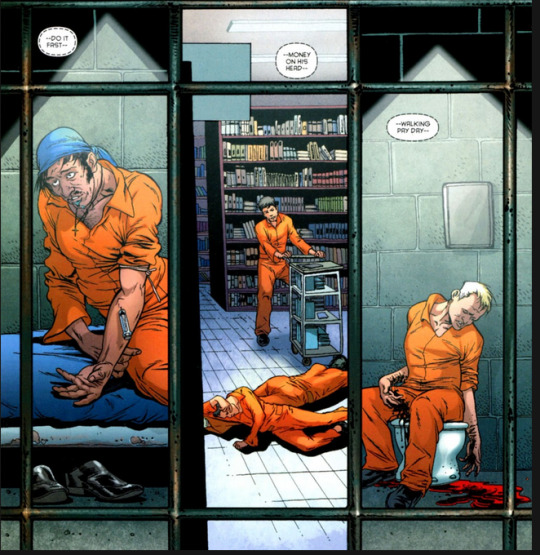
Give "come fuck me" eyes at a bunch of naked men in the prison shower, then proceed to kill them all one by one. I'm also counting the brother and his thirteen morons, even though that was in the past, so 20 criminals get shanked, prison-style. I will point out that each one of the convicts was trying to kill Jason at the time.
Later, we get the indication that Jason actually killed 14 people while in the slammer. He's really giving "you're locked in here with me" vibes.
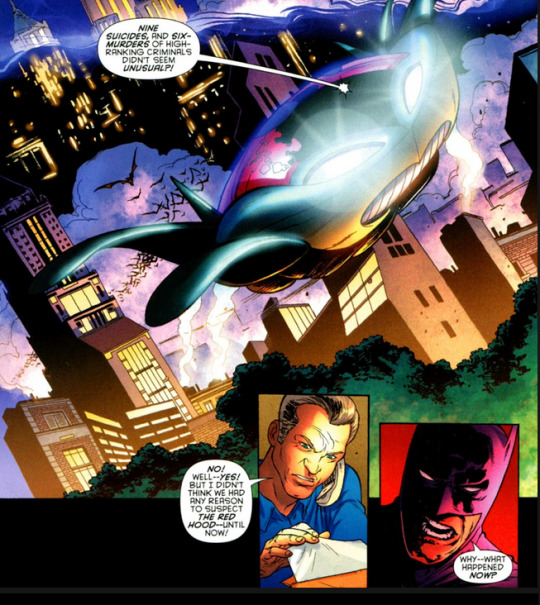
Counting the one guy's brother and his thirteen morons, that's a total death count of 29 thus far. Jason's off to quite a banging sta --
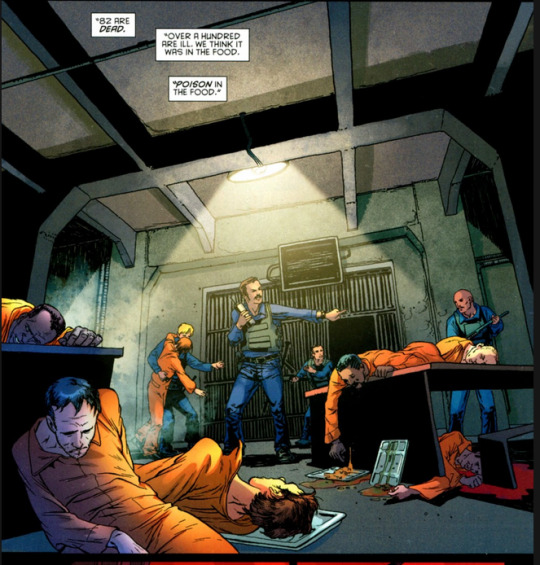
Jesus Christ.
And just like that, we're in the triple digits at 111 dead. The warden, pretty reasonably, wants Jason sent back to Arkham Asylum, but en route their police convoy gets attacked by...these guys:
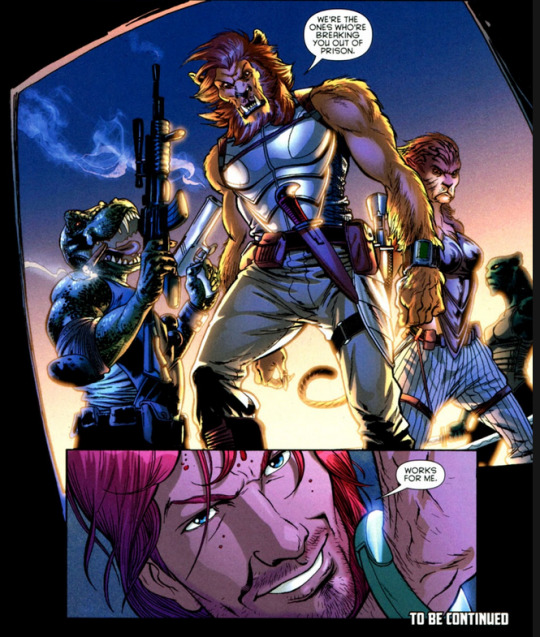
Jason goes along with the Menagerie, as they're called, for all of ten seconds before trying to break free. In the process, he kills one of them before their boss reveals that she has Scarlet, aka Sasha, the teenaged girl who was briefly Jason's sidekick. There's a whole adventure in which Red Hood teams up with Batman and Robin to rescue her, and Dick makes it very clear to Jason that he expects Jason to not kill anyone during this fight. Interestingly, Jason obeys. Therefore, no further death tally.
Conclusion: 112 (111 inmates in the prison and 1 would-be rescuer)
31 notes
·
View notes
Text
Genazo cheat sheet: Blink and you'll miss it edition
Another post where I try to list interesting details and tidbits about the movie, easter eggs, and such. I will try to follow the movie chronologically, but there might be some back-and-forth. Of course, this will include spoilers. If you're interested about Gegege no Nazo trivia and context, I wrote two more posts on the subject, here and here.
This movie is packed with little details that gives it insane rewatch value (I went to the theaters too many times...), either as references, easter eggs, or small touches that give not only historical accuracy, but also breathe more life into the characters and the world they inhabit. Let's go for another deep dive under the cut!

- Opening scene, present time
Yamada
His name and appearance evokes Salaryman Yamada, a character part of Mizuki Shigeru's star system. I won't go through all of them, but multiple characters in Genazo are part of that star system, like the section chief and the president of the blood bank, some of Osada's henchmen, etc. (here a star system refers to the use of a rotating cast of characters put into different roles through different stories but retaining key characteristics, either in design, personality, etc. Tezuka Osamu is known for this practice as well.) But specifically, Yamada reminds me of Joho-ya, "The informant", or "Hunter" (in Inka-subs), from Akuma-kun!
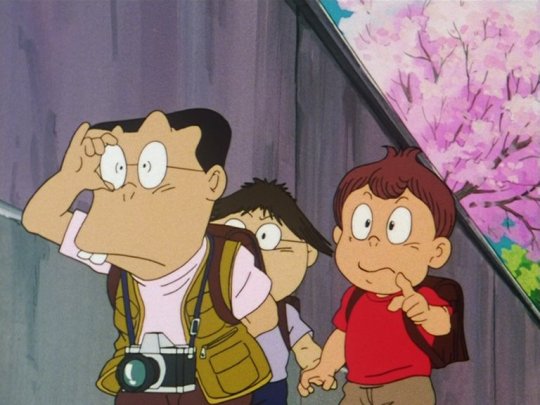
Ruins of Nagura village
As Kitaro's group and Yamada go through the village, you'll notice obvious items that played a part in the movie : the Sengoku-era armor, the hospital beds, Tokisada's ball form, etc. In the shot where Medama Oyaji says "The time has finally come, 70 years later...", Katsunori's car is in the foreground. Yamada stumbles upon the armor which I already mentioned, and is fairly obvious, but please notice the skull on the helmet: its left eye is worn-out! He then gets jump-scared by an Ichimatsu doll, which seems to have belonged to the little girl coughing in the train Mizuki and Gegero rode to Nagura village. Interestingly, though the patterns on the fabric are different, she shares the color of her kimono with Sayo, and both wear a bow in their hair. Finally, when Yamada points his flashlight at a window, a ghost appears for a frame or two, wearing a headdress making it looks like someone working for the Ryuga family. Which brings us to our next point... !
Hidden yokai and ghosts.
Mizuki Shigeru's daughter, Mizuki Etsuko, wrote the lyrics for Gegege no Kitaro 6th series' 3rd ending theme : "Mienkeredomo orundayo", "You can't see them, but they are here".
And indeed, if you look closely, or if you close one eye, you'll find that yokai have been present in the story way before Gegero made Mizuki notice them. Frankly, I don't know if I found them all, and what I can show you is mostly thanks to the joint effort of movie-goers who shared their findings online, but here are those I could spot and screenshot! (if you found more, Pleaaaaaase!!! Let me know!)

First, the ghost lady in the opening scene.

Mizuki casting two shadows in the blood bank office.

The tengu-like face appearing on a tree trunk as Mizuki enters Nagura village.
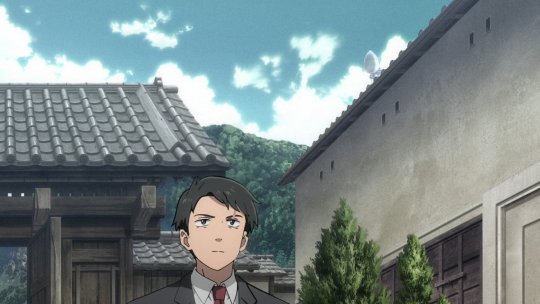
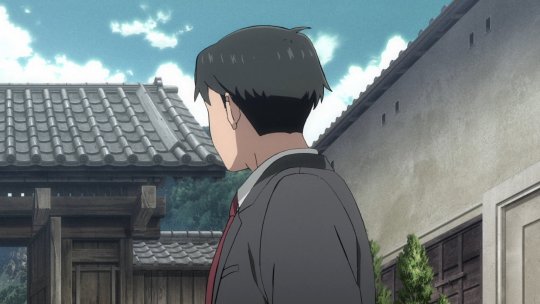
Kashabo, sitting on a tile as Mizuki enters Ryuga mansion grounds.

Probably Ikkenya no Yoju's paw, whom will appear again later in the movie, when Nezumi comes to give the diary to Mizuki in the storehouse.

The night after Tokimaro was appointed new family patriarch, Yuurei akago appear on the shelf in the back. (and these are actually pretty easy to spot, if you aren't so focused on Mizuki's cleavage. Yes. I know. Don't hide it.)
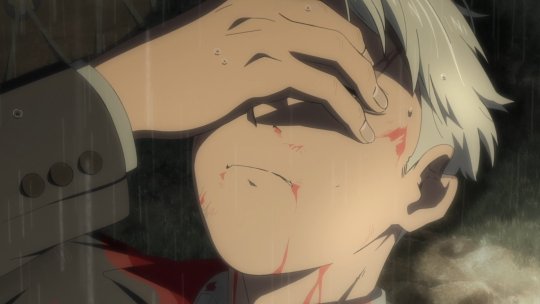
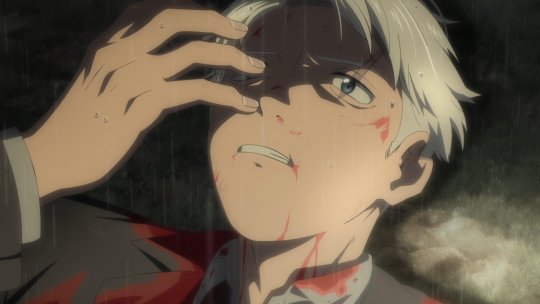
A soldier's helmet appearing next to Mizuki and disappearing a few frames after.
I read about more findings on social media, but it's all I collected myself for now!
Showa 31, Tokyo.
Or 1956.
Trash in the water, a cramped, shabby strict in the foreground, the blood bank, and in the background, factories releasing smoke. Far from the Tokyo that Tokiya and Sayo imagined, right?
As I mentioned in another post, the people waiting in the stairs came to sell their blood, and most of them probably do this for a living.
The celestial eye goldfish, or Choutengan, heavily bred in Japan and popular in art, are only found in captivity. They lack a dorsal fin, have limited vision, and can only be kept in aquarium on their own.
Train to Nagura Village
"...Tokisada is the man behind that success story." A script note I should have included in the previous post but I forgot, oops. Mizuki calls Tokisada "立志伝中", risshidenchu, conveying the idea that he is someone who worked harder than everyone in order to achieve great success.
Mizuki smokes "Peace" brand cigarettes. Its name was chosen with hope for the future after the war.

It seems Mizuki brought only one pack of cigarettes with him, as a pack of "Peace" contains 10 cigarettes, and he is seen smoking 10 times throughout the movie. The first time is in this scene, inside the train.
Tobacco's price in Japan has historically been exceptionally low, and at the time period Genazo takes place in a consequent percentage of people smoked - with a lack of awareness for safety, especially in closed spaces and around children, which was sadly not exclusive to Japan. Notice the girl holding the Ichimatsu doll and coughing : one of Osada's henchmen is sitting across from her, looking in her direction. Later in the movie, inside the underground factory, a smaller patient is on one of the hospital beds coughing, as a concerned patient turns to look at them. The doll is seen thrown in the trash, and of course, found again by Yamada in present time.
"Many people are following behind you." The silhouettes behind Mizuki are similar to the Japanese military uniform seen in his war flashbacks. So it's his war companions following him, and not the ghosts of enemies.
(a lot of points from the taxi drive to Mizuki's arrival in Naguramura I feel I already covered in other posts, so let's jump ahead a little bit.)
Reading Tokisada's will
Staff has cited The Inugami Family, movie adaptation of the novel The Inugami Curse as an inspiration for Gegege no Nazo. It's at the most explicit in this scene.
Tokimaro wears a sokutai outfit associated with noblemen of the Heian period. He also has teeth painted black, a practice called ohaguro, popular again between the Heian and Edo periods, mostly for cosmetic purpose ; and white makeup. Mizuki mentions how Tokimaro hasn't made public appearances in a long time due to poor health. Is the makeup for concealing his health...? In a previous post I mentioned how Toshiko, Hinoe and Otome share a motif reminiscent of the "inoshikachou" (boar, deer, butterfly) card combo in Hanafuda. Tokimaro's design is reminiscent of the Ono-no-Michikaze Hanafuda card.
Tokimaro mentions not being allowed to take a wife, surely not to dilute Tokisada's blood.
A maid places a zabuton cushion for Mizuki to sit on, just like everyone else in the room. However, during the entire scene, Mizuki keeps kneeling with his head low : Otome is already not pleased by his presence, but on top of that the maid placed the zabuton between two tatami. Tatami's edges are covered with cloth, and the fancier ones are embroidered with the family's emblem ; it would be considered rude to step and sit on it. He was also never invited to sit by any of the Ryuga, so he remains kneeling next to the zabuton.

Tokimaro's death, Gegero's arrival
"I really hate conflict, you know. How about it? Why don't we all take a bath together and relax ?" Kitaro's father's love for baths is well known as Medama Oyaji. In the Birth of Kitaro manga, he also mentions how the Ghost Tribe are peaceful people.
It's a rainy morning, and when Osada's men attempt to behead Gegero, Mizuki rushes outside shouting to stop them. He's only wearing socks in that scene, which is why he goes barefoot in the next scene when he's in the room where Gegero is locked in.
"This person has brought calamity upon the village..." In the shot where Osada says this line, he's drawn wearing a ring. I'm not sure if it's intentional or an animation mistake, but I think it's the only scene he's seen wearing it.
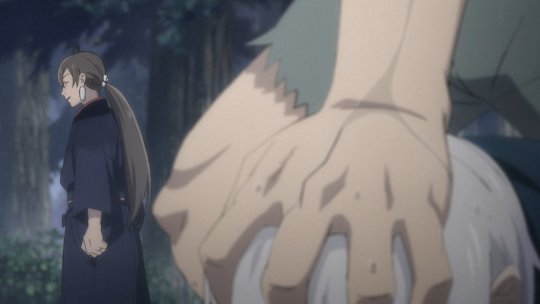
Night after the murder
Otome feels weak, and Osada doesn't just catch her as she falls, he tightens the embrace as if comforting her in a hug. In the following scene, it seems Hinoe got money from Otome, who is drinking red wine.
In the jail cell room, Mizuki is eating a classic meal of white rice, grilled fish, miso soup, and takuan (yellow pickled daikon radish). Gegero is eating a much lighter meal of brown rice and takuan sliced so thin it's see-through... In the previous scene where Osada, Otome and Hinoe are talking, Osada mentions that the room with the jail cell is in his quarters, which is why Tokiya was able to come in. Mizuki was also given a different yukata than when he was sleeping in the annex room of the Ryuga.
Gegero tells Mizuki that "Some people are not worth engaging in conversation." Indeed, he tried to warn Mizuki in the train that hell was awaiting him, but he didn't listen and came to Nagura Village anyways...
Asking Katsunori to let Gegero out
On the way, Mizuki passes by an old lady wearing a headdress and rubber gloves.

She's probably coming from or going to the underground factory where M is produced, and is also likely the ghost Yamada caught in his flashlight at the very beginning of the movie.
Hinoe is seen drinking alcohol as she peeks at Sayo and Mizuki from the window. In the room is a man in a futon, and a suitcase full of jewellery. The day before, in the scene where Otome, Osada and Hinoe were together, Hinoe was counting money she probably got from Otome, promising she wouldn't waste any of it. It seems she spent it in jewellery from the man in the futon, who is probably an outsider.

Hinoe is watching the scene from this balcony, and you can see two sets of tire tracks : the ones going straight is from Katsunori's car who just passed by. So the ones turning are probably from Hinoe's visitor, the jewellery seller, coming from outside the village. Had Mizuki paid a little bit more attention, he would have realized that Otome lied about the landslide at this point...!
In a previous post I talked about Tokimaro and Katsunori's placement in the succession scene, Katsunori sitting in front of a dragon, placed inside its maw.

This time, behind him are displays of his vanity : a replica of the "King" (osho) shogi piece, and peacock feathers matching the color of his cravat. He's drinking Grand Old Parr Scotch whiskey, contrasting with Otome drinking red wine a few scenes earlier.
First time on the forbidden island
In front of the well, "呪" (kashiri) "Curse" is written on the torii gate.
(lots of important things happening that I already covered in older posts, so let's flash forward again)
Back at Osada's house jail cell
Gegero is eating zaru soba. They are cold buckwheat noodles that you dip in tsuyu sauce before slurping. It's a great dish to have during the hot Japanese summer! There are two ozen (low dining table/trays) in front of him, one with the soba, and the other with an empty spoon and bowl. It seems that this time, Mizuki shared his dinner with Gegero.
Discussing next plans
"And as long as [the Kyokotsu] doesn't have a vessel in the village." Here, Gegero specifically uses the word yorishiro which I chose to replace with "vessel", but yorishiro is a word specific to shintoism. It refers to an item or body that can attract and host a kami (deity). You may have seen before shimenawa ropes tied around rocks or trees - they signify that a kami resides inside, making those yorishiro. It's possible that at this point in the story, Gegero might have already figured out Sayo.
After finishing his popsicle, Mizuki flips the stick and looks at it, then seems a little bit disappointed. Some popsicles have written on their stick either hazure (lose) or atari (win), on the end which is visible only after finishing the popsicle - had Mizuki gotten a win, he could have had another popsicle for free! Aww...
Sayo and Mizuki on the balcony
Sayo wears a fashionable, western dress. She may have gotten it from outside the village, possibly from Katsunori. From this point, she starts calling Mizuki "Mizuki-san" instead of "Mizuki-sama", closing the gap between them.
Moonlit talk in the graveyard
Throughout the movie, you can see many electric poles, but in this night scene, no lights are on at night except from Tsurubebi :

It's possible that most of the electricity is used in the underground factory.
"I saw it in the south..." When Mizuki mentions the south, he means Rabaul, New Guinea.
After lighting his cigarette with Tsurubebi, Mizuki notices he took his last one (the tenth) and crumple the empty cigarette pack in his pocket. It's why he shares it with Gegero instead of giving him a new one ; an interesting twist of fate right when Mizuki asks himself if he will have his own fateful encounter one day.
Gegero and his wife enjoyed "cream soda", which I left as is in the subs, but I realize that these are actually called soda floats in English, oops. Melon soda floats are heavily associated with the Showa era ; go to any vintage store, museum gift shop, etc and you'll find amongst retro goods something melon cream soda themed. (Pancakes and "pudding a la mode" are desserts with a similar iconic retro vibe) Cherries are also a known favourite of Medama Oyaji!

Their date spot is in Asakusa, Tokyo. You can see Sumida river in the background, with what I wrongly assumed to be Ryogoku bridge at first, but is actually Kototoi bridge. Starting from there you can find the exact spot : The rooftop amusement park "Sportsland", opened in 1931 in the Matsuya mall building. The mall remains nowadays, but not the park, sadly.
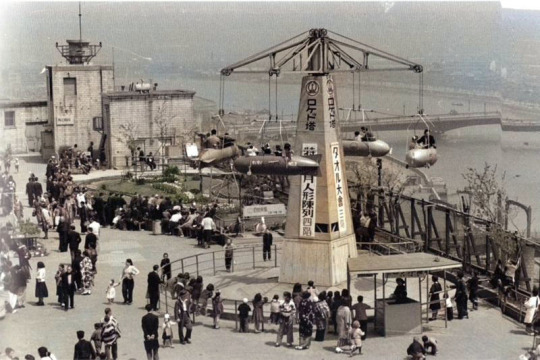
Picture source

flash forward to...
After Gegero's capture
In front of the shrine, when Otome reveals the role of women within the Ryuga family, Osada's shoulders slump, pained by the thought.
Inside the underground factory, you can see the same headdress and rubber gloves wearing old lady, grinning while at work.
As I stated earlier, we meet the coughing little girl from the train again here.
Sayo asks Mizuki, "Are you going to help that person from the Ghost tribe?" even though she has never met Gegero on screen - Either she was spying on Mizuki and Gegero, or she figured it out after reading Tokimaro's diary. "If I run away now, this guy will laugh at me." Mizuki says. Indeed, Gegero accepted to work with Mizuki on one condition : "Whatever you see, do not run away."
Bloodbath
Sayo's Kyokotsu releases more smaller Kyokotsu from its rounded stomach, as if giving birth.
During the bloodbath, one of the Urakido is not killed by Kyokotsu, but by one of his fellow man who accidentally slashed his throat while swinging his sword.
When Otome calls Osada for help, he shouts the usual okusan, "Madam!", followed by her name, "Otome!" in despair.
The anger Sayo feels for Mizuki is different than the grudge she bears towards the Ryuga and the villagers ; she chooses to strangle him with her own hands rather than through Kyokotsu. When Gegero said that he felt pity for Mizuki, Mizuki similarly went for Gegero's throat.
The bottom of the well
"By now, [Tokiya] must be bullied in hell in my place." "今頃 余に代わって 地獄で 獄卒どもに いじめられとるだろう" ima goro yo ni kawatte, jigoku de gokusotsudomo ni ijimeraretoru daro Literally, "by now, he must be bullied by the Gokusotsu in hell in my place." Gokusotsu are the guardians of Hell - they are seen in Gegege no Kitaro anime, working for Enma Daio. It's wrong of me to have omitted them in the subs, but I didn't know how to phrase it with proper length and timing. I'm sorry.
Mizuki climbing the stairs dragging the axe behind him mirrors Gegero's arrival in Nagura Village - the sound of the axe hitting the ground replacing the karan koron of Gegero's geta sandals.
Gegero places the chanchanko for protection on Mizuki's shoulders, but later Mizuki put it on Gegero's wife instead - Mizuki didn't hear Gegero says his "my friend, the future in which you live is something I wanted to see with my own eyes" line after all. At this point, Mizuki has nothing left to lose or look for himself, as highlighted in the shot where Gegero and his wife reunite, and Mizuki is lying as if dead on the foreground while Tokisada speaks of the bright future of Japan. He is ready to pay the price for his actions, even if it costs him his life.
When Gegero removes the seal on the pile of skulls, it's lodged in a skull's left eye socket.
Present time
Yamada promises that whatever happened in this village, he will "definitely write it down and pass it on." His article was printed in the pamphlet sold at the time of the movie's theatrical run.
Ok... phew! I think that's enough for now. If you've read this far...congratulations!! Unfortunately I may still have things to say in the future, but that post is way too long already. Thank you for reading! I hope this helped you notice a few things. Enjoy the movie!

110 notes
·
View notes
Text
Snow White in France: French folk-fairytales (FFF)
In honor of all the confusion, so-called "scandals", pseudo-rediscoveries and insane takes surrounding Snow-White recently, I decided to make a post about the French variations of this fairytale-type. A little reminder that Disney's version (and the Grimms' one) is not the only Snow White around.
Now the interesting thing with Snow White is that this is a very, very German fairytale. Unlike stories like Cinderella or Little Red Riding Hood, which were popularized by dual versions (French/German) Snow White is very clearly on the German side - it is first and foremost the story as reconstructed by the brothers Grimm. The international fairytale-type (from the ATU catalogue) is built around Schneewittchen. And "Snow-White"-like fairytales are distinctively absent from the literature of France. We do not have any literary Snow White around here - except maybe for this one text of Alexandre Dumas, "Blanche de neige" (Snow of white) which is just a loose translation of the text of the brothers Grimm with Dumas adding a few secondary details of his own invention.
In the absence of literary "Snow Whites" in France, we need to turn to the folk fairytales - the versions of the stories collected by cities and countrysides out of the mouths of grandmas, children, nurses and other storytellers. And of course, for this we shall turn to the Delarue-Tenèze, the local French version of the ATU catalogue.

And interestingly, while the Snow-White type (type 709) does exist in France, it is not a very massive or popular one... And it doesn't seem to be truly "traditionally" French. Perhaps because in France our national version of the "sleeping princess" is Sleeping Beauty? The annotations for the fairytale type in the catalogue do note that the roots of the German tale, in terms of "fairytale chronology" are within the Pentamerone directly - many tales of the Pentamerone popularizing and spreading elements that would later become Snow-White ingredients (the motif of the colored beauty - usually white and red, sometimes with black - the motif of seemingly dead girls in glass caskets suddenly waking up ; the motif of a fake unnatural sleep that someone must be awakened from, etc etc... In fact, and this is a very telling element: the opening of the Grimm story, with the motif of the colors of Snow-White (white as snow, red as blood, black as ebony) sems to be mostly absent from French variations of this story-type...
The Italian influence over these versions is most clearly seen within, of course, the Corsican variations of Snow-White. A first version, "Anghjulina" or "Angiulina" begins with a very short and succint, elusive tale. It is the story of a widowed mother, who simply "can't bear to look at her daughter" anymore. She just... she just can't stand it. She goes to seek bandits, ordering them to take her daughter in the forest and kill her - and when the bandits ask her why she would do such a thing, again, she merely says that she "can't look at her". But of course, the bandits cannot bring themselves to kill such a "nice" girl, and they rather take little Angiulina to their pretty house in the maquis, where she lives with everything she needs - with the bandits leaving in the morning "to go to work" and returning in the evening, telling the girl never to open to anybody. The murderous witch in this version is not the mother herself, but a "wicked witch" who used to live within the same village as Angiulina and one days randomly tells to the girl's mother Angiulina is not dead. And it is by order of the mother that the witch disguises herself as an "old woman" to kill her.
First she appears as a seller of ribbons and lace, and to enter the house she invokes Angiulina's pity claiming she is cold and merely asks for a bit of warmth. After the girl gives her a bowl of hot coffee (we are in the south after all), the old woman insists on rewarding the girl - Angiulina claims she has everything she needs, but the woman insists on giving her... a book. Yes, in this story the deadly trap is a book. The witch insists that Angiulina may have all the books she wants here, but she doesn't have this book - and since Angiulina refuses to take it, she just places it by the chimney's mantle before going away. When the bandits return, they immediately tell her to take the book with a spike to throw it in the fire - and the book screams as it burns, proving that it was "the work of a witch". The witch's second disguise is the one of a seller of jewelry - and again, she convinces the girl to open by claiming she is extremely cold. After a new bowl of coffee, the witch want to reward her - and since Angiulina says she has "everything she needs", the witch offers to do her hair, to make them curly... But as the witch twists and turns every lock of Angiulina's hair, she casts a spell on her that keeps her frozen and mute but with her eyes wide open. "She was incantada - enchanted!" the text says.
Now the bandits do not bury the girl in a glass coffin here - but they build a "shrine" for her by the edge of the forest, an "altar" they ornate with flowers and candles (that they lit up every morning) and on which they place the frozen Angiulina within the very chair she was sitting into. Next the "prince with his servant" arrive and things get... even weirder than in your usual stories. The prince first tries to talk with the girl sitting in the chair by the forest, due to how she seems so alive, but upon noticing she doesn't move or talk... He has his servant take her away and locked in his room, without anybody being warned of this. He doesn't even talk to the bandits, he just... straight up steals Angiulina away. We are told that then the prince refuses to let "anybody" enter his room, not even his own sister, and that he barely eats anymore - but his sister, arriving one day unannounced, spies on the girl in the room and understands it is the source of her brother's bizarre behavior. She forces him to let her in the room, and notices how the girl doesn't answer - but also noticing how twisted her hair is, the princess untangles them... By summoning a blacksmith. Yeah, apparently they are SO tangled only a smith that un-twist them. (Also, something something about how blacksmiths were thought to practice magic or be sorcerer-adjacent). As soon as her hair was untangled, Angiulina could speak and move again - and she married the prince. The end.

Another "Mediterranean" French version is from the Pays Basque - it is called "La mère jalouse et la jeune persécutée" (The jealous mother and the persecuted youth).
The story begins with a mother growing jealous of her daughter's beauty. Here again the mother is separated from the witch that shall inflict torments to the girl - but with the morbid added detail that here the wicked witch (who is specified to only seek to do evil) is the girl's GODMOTHER. Yes, an evil witch godmother. The witch here fulfills the role of the "magic mirror", as she purposefully compliments and glorifies the beauty of the daughter to make the mother's jealousy grow and grow - until the mother asks the witch to take the girl away from her, because "seeing her is a torment". The witch takes the girl over for a promenade, but then pushes her at the bottom of an empty cistern, where th girl remains for THREE DAYS tormented by hunger and thirst, calling for help. And after three days she manages "somehow" to escape the cistern.
Wandering in the wilderness, she discovers a great palace with a table prepared for twelve guests but nobody in the castle. Scared, the girl hides in a corner, and on the stroke of midnight twelve thieves arrive to eat their meal, leaving the next morning. The story then follows one of the "girl seeking her brothers" paths - as the girl cleans the palace, makes the bed, washes the dishes and cooks food before the thieves return. They decide to have one of them stay behind to spy on who mysteriously did all that - the little girl comes out of her hiding place when the thieves leave, only to get caught by the eleventh thief... And he ends up liking her so much not only does he defend her against the other thieves and says she should stay as their caretaker - he even marries her!
Now at this point the witch discovers the girl is still alive, and rushes to the mother to warn her... Only for the mother to not care at all. In a fresh twist, here the mother is satisfied with wherever her girl is as long as she doesn't have to see her anymore - making it literal the fact that she can't "see" her daughter anymore. But the witch, who hates anybody being happy, decides to still ruin the girl's life just for the sake of it. So she goes to the castle... and presents herself upfront to the thieves. No disguise, she says she is the godmother of the girl in the house and the girl's husband is too happy to welcome her. The witch plays nice, and offers her goddaughter the "prettiest little white bread" ever. Now, the girl is not stupid, and she refuses to take it - but her husband who doesn't want to offend the godmother insists on the girl taking at least a bite out of it... Which prompts the girl to fall asleep and the witch to vanish in thin air.
After waiting for THREE MONTHS for the girl to wake up, the thieves decide it is time to do something - and they just put her in a "glass coffin" by the river. Then the "prince" comes - who is here just a gentilhomme, a young nobleman. Seeing the girl in the casket he is said to fall immediately in love with her, and as with the version above he takes her to his castle, locks her within his room, places her within a chair, and forbids anybody from entering his room - but in the process, seeing she does not wake her, he starts to grow sorrowful, skinny and unhealthy. Here it is not a noisy sister who breaks the spell - but the governess of the house, who out of frustrated curiosity uses one of her own keys to open her master's room, and then gets offended at the girl not answering her questions. So she slaps her in the face for being a rude brat (she seems to be one stubborn governess) and apparently this slap is enough to break the spell - with some comical effect as the girl has no idea why she is here or even where she is. The governess takes pity on the child upon hearing her story, and when the gentleman returns he promptly marries her and they have a child. (What happens to the previous husband? Who cares and nobody knows!)
Now the story actually continues here, down the "false bride" path, as the witch godmother is still on her journey to persecute the girl. Again using her godmother status as a way to enter in the castle while the husband is away, she plunges an iron needle in the girl's head to turn her into a dove, and then replaces her within her bed. However the dove can still speak with her human voice, and she asks the servants around the castle where is her husband and if he forgot her (the husband did notice how now his wife suddenly has "a yellow skin and wrinkled cheeks" but he can't explain himself this sudden change - he apparently isn't the brightest bulb). When the dove starts harassing the witch, the witch orders the gentleman to have the bird cooked in salmis or killed on the spot. The husband, shocked at his wife's new cruelty but still confused about the situation, taks the bird to the governess for her to cook it... Only for this rude-awesome governess to yet again solve the situation with brute force - as she basically scolds her master for trying to kill such a pretty animal, then says she is tired of how her mistress grew capricious and bossy and unhappy with everyone ; "And if she wants to attack me, let her come and try." Noticing the iron nedle in the dove's skull, she just rips it apart, breaking the charm... And the witch is very promptly shoved in a burning bread-oven.

The fact that this Snow-White tales derives into other types of folktales is actually not that surprising. The Delarue-Tenèze comments do point out how in France the Snow-White stories usually only partially fit their type - usually devolving or being mixed with other fairy-tale types.
A third version of the story was collected from the llle-et-Vilaine area (Bretagne), and has the peculiarity of... being cut short, compared to the versions we know of Snow White. Called "The seven dwarvs" (Les sept nains) it begins with the description of an "unusual" family within a village - note how so far the heroine is very often a villager, not a princess - who are kind, generous, nice, hospitable people of a quite wealthy situation... but yet are a family ruined by an inexplicable hatred between the mother and the daughter (it is unclear if there's just one daughter, or if she is the oldest of several). "According to some vile-tongued neighbors" the origin of the conflict is that the mother, a "strong and robust woman" fears her daughter's charm shall overshadow her beauty ; but the narration promptly points out that the daughter in question despite being sweet and patience, still has a rebellious spirit. She hates how her mother keeps isolating her, locking her in her room, forbidding her to go to the village festivities - and the father, who is a "weak" man, sides with his wife rather than his daughter.
One day, a quarrel started between the two woman, which degenerated into pure violence as the mother took an axe and promised she would kill her daughter, and the daughter "avoiding the attack", flees out of the house swearing to never return. She wanders through the village, and in the field, and up to the forest, without any proper clothes or food for the journey. She finds herself in front of a step, dangerous cliff, and since she doesn't want to turn back, all she can do is enter a grotto she finds, half-hidden with ivy. It is a "small hole" at first (she must bend herself to enter) but it grows bigger as she explores - and she is massively surprised to find in the end, bathed in light, tiny house-rooms. A beautiful, ornated dining room with seven exquisite meals prepared ; a tiny kitchen filled with clean utensils (many of which she doesn't even know), a comfortable and cute bedroom with seven beds and seven washing-sets ; finally a workshop with tools for mining and other stone-related labor. The light comes from a colorful glass window on the ceiling.
Carefully she sits on a little green chair, and with a tiny silver spoon eats a bit of the soup from each plate, before going to sleep - but on the carpet on the floor rather than any of the beds. When the owner of the house, the seven dwarves, return, they are angry at someone stealing their food - and snatch all the tools and weapons they can find to attack the intruder... But are shocked upon seeing it is a "pretty, rosy-cheeked, sweet-eyed girl with long blond hair". She explains she just came here because her mother wanted to kill her... The dwarves then "celebrate" her and joyfully welcome her - saying she shall be their "queen" (which is said to be a loving nickname/familiar title they give her to show their love) and they shall be her "familiar spirits" - though they insist on everybody keeping their own freedom and independance. The girl meanwhile, says she doesn't want to go outside anymore out of fear of "being taken back", so she agrees to rather be the "sisters" of the dwarves (but they still call her their queen nonetheless while dancing in circle around her - we are notably given a description of their outfit, with feather-ornated caps, green clothes and black boots). And a deal is striken: they shall defend the girl's beauty and life, they shall offer her protection and respect, and as a thanks for this she agrees to cook for them and take care of their house while they are away.
And... that's it. The story abruptly ends here, with the girl living happily ever after as the "queen" of the dwarves, still singing to this day loving songs about her. The end. No more adventures.
I think it is quite fascinating how we see that the traditional "fairytale type" can actually be cut short without it actually harming the plot per se, or robbing the heroine of a happy ending - since here, being found by the dwarves and living with them, having them replace her dysfunctional, toxic family, is presented as the happy ending. It is also very frequent to see in "folk fairytales" how what we know as longer or more complex stories gets fragmented into various tiny tales which work very fine on their own.
There are more versions from Bretagne of the Snow-White story, but this shall be for another post...

16 notes
·
View notes
Text
Compilation of all the pictures in the official Anais Watterson Flickr account (with the Original Image Resolution)
You can find the account here !! Just wanted to share all these neat images since I find them aesthetically and visually appealing. I'm sorry if this has been done before, this is mainly for my personal archive. More information under the Keep Reading !!!
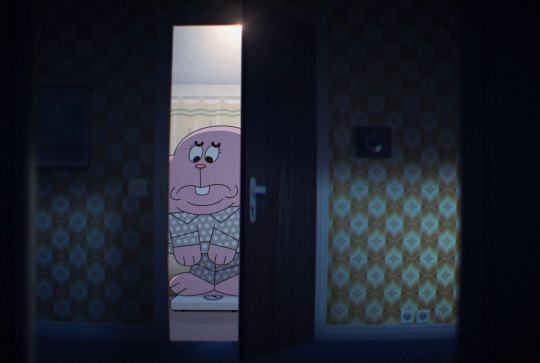

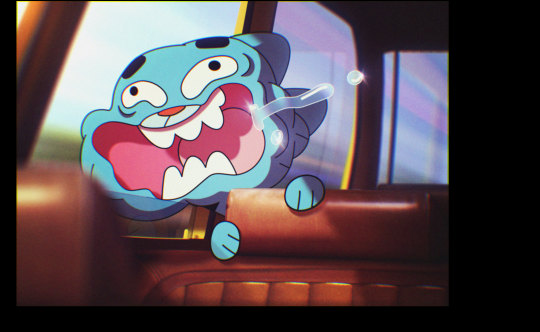








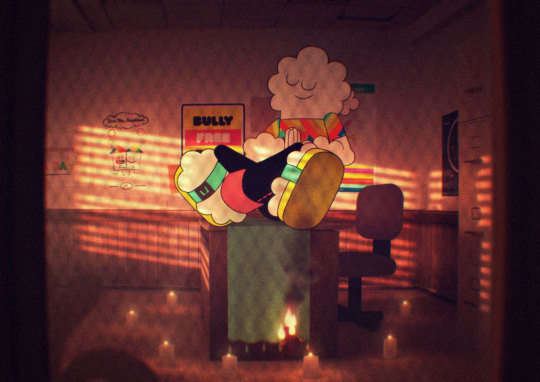


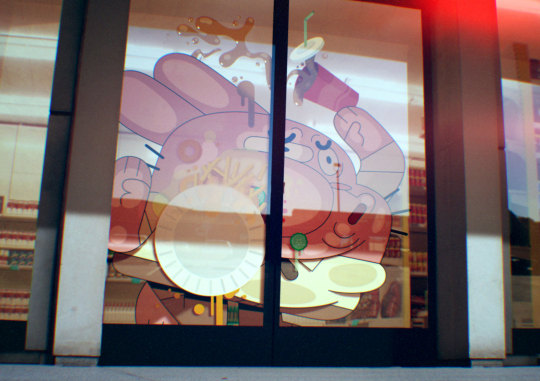
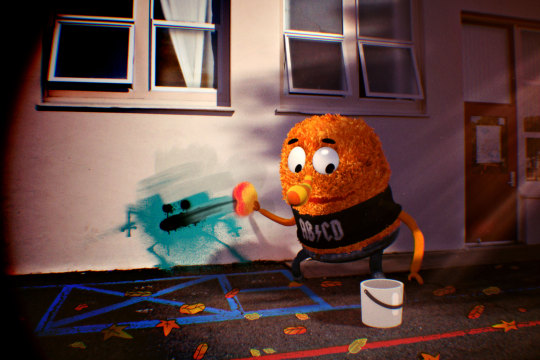
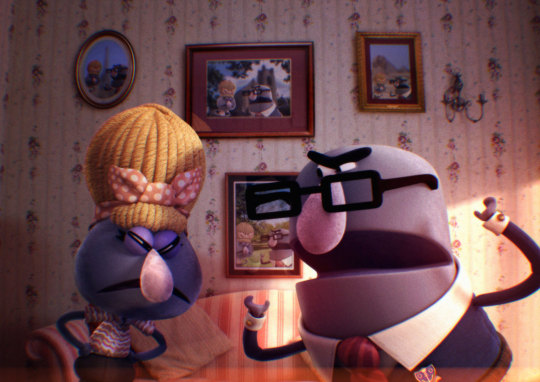



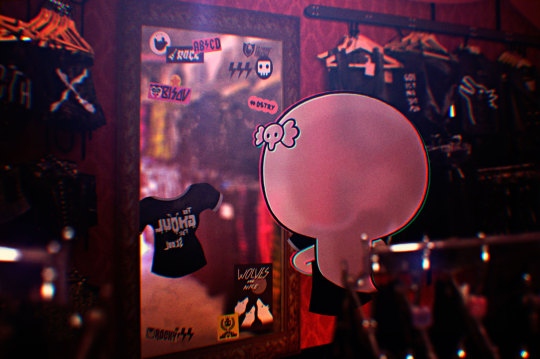


All of these were downloaded in their original image quality from Flickr. Images going from chronological date (oldest to newest). First image: September 5th, 2011 Last image: December 19th, 2011 Anais apparently shot all these with a Diana mini with flash, according to a comment she answered on the First image

The only other time she responded to an image is the last one, where she announces the end of the photo series due to "a lack of film".

Anais also put titles to all the images, which I included in the image descriptions. [EDIT] She has 262 followers (as of August 6th, 2023, 8:35PM CET), isn't following anyone, and joined in March 2011. From the art style and dates we can guess this account was made at the time Season 1 was, the last image being posted a few days after "The Club" was aired. The first image was posted the exact day the episode "The Goons" was aired, according to the TAWoG wiki. Interestingly enough, she has two albums on Flickr. One titled "Elmore" (16 photos), the other titled "Family Life" (7 photos).
I remember when years ago you could access these photos/the account on the Cartoon Network games website too. It was a while ago and I'm not too sure of the date, but It could've been around 2014-2017 (?). If anyone else remembers it or can find a snapshot of it on the Wayback Machine, freely add onto this post whenever ! On her About page it reads "Take a look at some of the pictures I’ve taken around Elmore with my brand new camera! Enjoy!" and has a link to theamazingworldofgumball.com, which now redirects to the Cartoon Network games website, but at that time it could've looked like this:

Note: this snapshot was at September 25th, 2011
That's all the information I could find of the official Anais Watterson Flickr account. If anyone else has more info on it, feel free to add on to this post !! This was made for archival purposes, in case the account or website ever shuts down.
#tawog#the amazing world of gumball#anais watterson#gumball watterson#darwin watterson#carrie krueger#richard watterson#rocky robinson#tawog bobert#larry needlemeyer#gaylord robinson#mr small#okay why are there so many people featured here#cartoon network
347 notes
·
View notes
Text
The color red in mob psycho 100
So I've been thinking about color symbolism in mp100. And I've assembled a roughly chronological analysis of the moments that red is particularly symbolically interesting, in my eyes, anyway!
(buckle up, this gets long. also, warning for blood and a little bit of gore. I talk a lot about the Mogami arc in here.)
What got me interested in the color red in particular was the fact that Mob's eyes occasionally change color from black to red. The first time we see that happen, it's in episode three of season one, where Mob snaps and unleashes his repressed rage against Dimple. (Interestingly, his aura is also unusually pink-heavy in this scene—usually it's more blue than pink, but along with the deep dull red of the background, everything in this environment is turning red.)

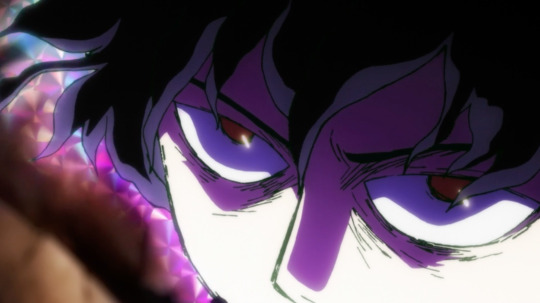
So, okay, we've got your standard red = rage thing. It's also interesting to note that Mob is usually a monochrome character—his gakuran (uniform) is black and white, his hair black, skin pale, eyes black and white—and when he gets simplified into anything more cartoony, he goes monochrome instantly. The only colorful thing about him is his powers, which are blue and pink. But here, when he shows his rage, he gets red eyes. Color is associated with emotion in general in mp100; in this same episode, when the narrator explains how Mob has locked away his psychic powers with his emotions, the emotions are shown in color, Mob himself in black and white.
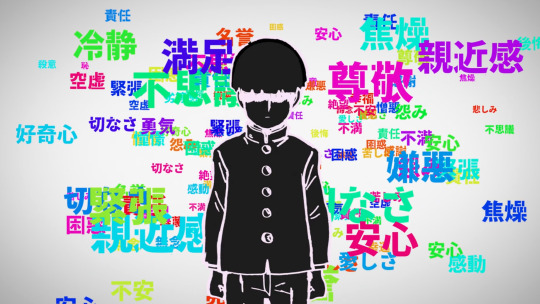
But I digress. Back to red specifically!
Coming right on the heels of the LOL cult arc comes the Teru introduction arc, where we learn exactly why Mob locked away his powers for good. He accidentally hurt his little brother—gave him a head wound, in fact, that bled copiously. Mob's memory of the event is fragmented, and it's all in washed-out blue, except for the horrible stark red of the blood splattered onto Mob's face and from Ritsu.

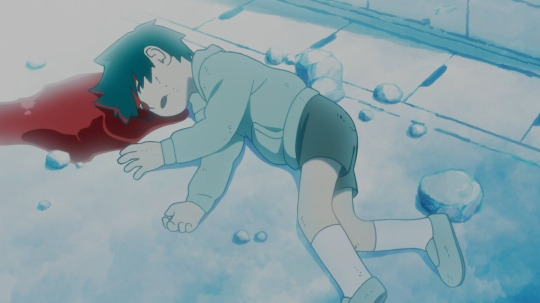
It's blood red. Mob's eyes turn blood red when he stops repressing his powers. Is it a reference to the importance of that red color to Mob personally? A kind of visual reminder that he can commit evil, can hurt others badly? In the Dimple arc, his eyes turn red when he becomes willing to exorcise Dimple—effectively killing him. Mob himself says "I'm terrible" when he reaches out to exorcise Dimple. Clearly the red ties back to that capability within Mob to hurt others, consciously or not. But!! It's more complicated than just "evil/willingness to hurt people". For one thing, the chronological first appearance of red in Mob's life is Ritsu's blood, which was an accident. When Mob's eyes turn red later, those are all instances where he has made a choice. And that choice is not always to hurt people—later, his eyes turn red in a moment of 100% courage. Red does not map perfectly to "evil" or even "rage".
We're almost to the Mogami arc, which is where this meta REALLY gets interesting, but first: season two episode three, which is easy to overlook but sets up a core question which the rest of season two answers. In this episode, Reigen gets a client who asks him to curse someone, and ends up cursed himself. The question which Mob ends up asking himself at the end of the episode is: if he, Shigeo Kageyama, ever wanted to curse someone, use his powers for evil, or eliminate people rather than spirits... would anyone try to stop him?
And!! look at the curse that ends up on Reigen's back in this episode!! It sets up the idea of curses (malicious actions taken against another person with intent to harm) as connected with the color red!
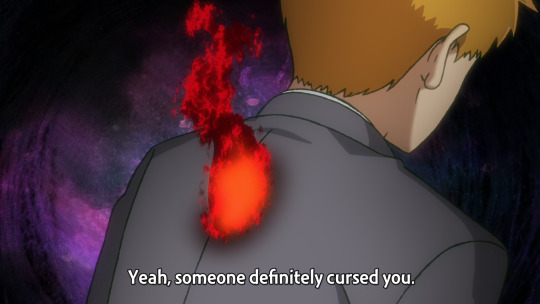
The next time red becomes particularly narratively significant, it's in season two: the Mogami arc (episodes four and five). Mogami's defining color is the exact blood red of Mob's eyes. In Mogami's aura, the red is mottled with black (see below, Asagiri Minori with Mogami's aura radiating off her.) His aura is nearly the exact color of the gore we later see him bathed in when Mob tries to exorcise his spirit and fails to achieve it. (side note, Mogami is controlling the entire world in that scene—this is a battle of imagination, and Mogami absolutely made that scene gory and horrible on purpose to upset Mob. his stated goal is to provoke negative emotions in Mob to make Mob realize that negative emotions provide more psychic power than positive ones, and to make Mob embrace vengeance and suffering as a way of life.)
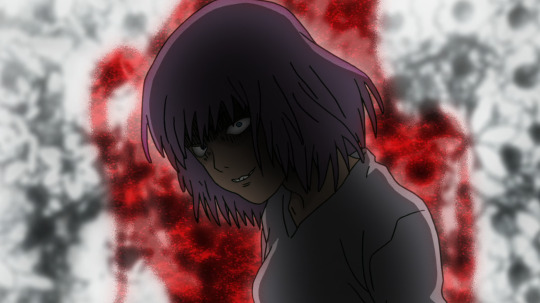

Interestingly, Mogami occasionally has red eyes too, just like Mob, but they're red in a black background, unlike Mob's red in a white background. (Slight tangent: Mogami's pupils get insanely smaller when they go red, whereas Mob's pupils actually usually get larger when they go red. I think that's because when Mob embraces his emotions, it's a widening out from his usual refusal to acknowledge his own emotions and willpower. When Mob's eyes go red, it's because he's seeing something he usually doesn't allow himself to see. Whereas for Mogami, both times that his eyes go red in episode five are narrowing moments when he begins to maliciously focus in on Mob specifically. The one below on the left is when he realizes Mob is trying to possess Minori's body to remove Mogami from the inside; the second is when Mob grabs Mogami with his aura while inside the mental space. Both moments are ones where Mogami begins to see Mob as a potential... second Mogami. A potential sympathizer—someone with a lot of power, which, in Mogami's worldview, comes from negative emotions. So Mob is like Mogami—someone who has suffered! When Mogami's eyes go red, it's because he has selected Mob as someone he could groom to be like Mogami himself. See below for Mogami's horrible little red eyes.)
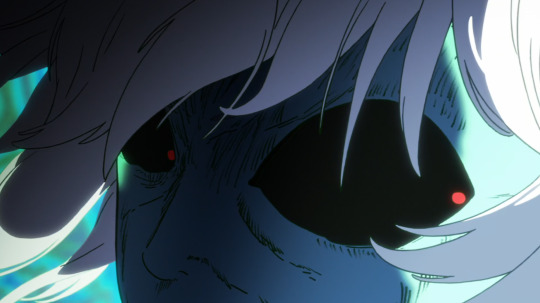
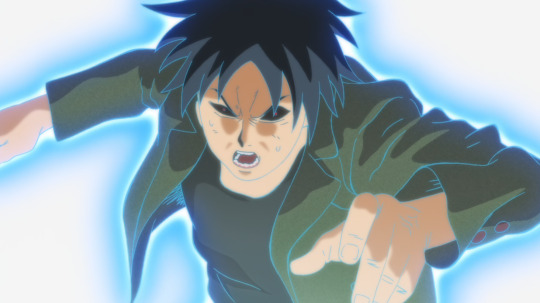
Once Mob gets locked into Mogami's artificial world, red continues to be symbolically important. It's the one saturated color allowed in a world of depressing grays, greens, and browns. A red glow indicates Mogami's presence speaking to Mob in his messy room. And red is the color of blood, of course, which appears again and again in Mogami's world. I won't belabor the point that it's associated with trauma, and specifically the trauma of Ritsu's head wound caused by Mob. Mogami doesn't know about that, but we the viewers do. The point of red in this world is the intentional, inexcusable causing of harm; Mogami tries to convince Mob that the only way to deal with trauma is to embrace it and become the trauma causer rather than the victim, bringing justice (red) to a bleak world (Dull Trash Brown/Green, the color of depression and meaninglessness in this show). See below.
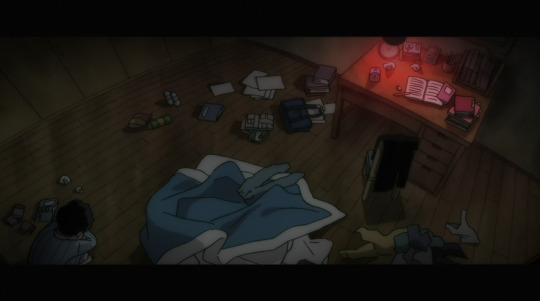
After (subjective) months of bullying, Mob gets a head wound and is subsumed in a despairing red haze, but fortunately, Dimple breaks him out of it, adding a much-needed pop of green color to the bleak-and-red world, a reminder that other emotions than bleakness and rage exist. and THEN it REALLY gets interesting!!!
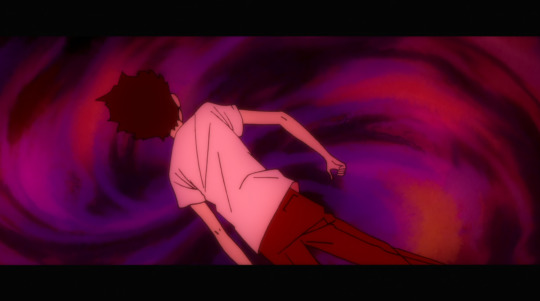
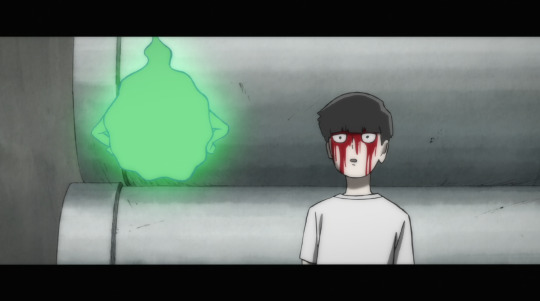
I've already talked (here and in this post) about the next instance of the symbolism of red in MP100: 100% courage!!! Despite being nearly consumed by despair (represented in Mogami's black and red) trying to fight Mogami's horde of spirits and break out of this mental world, Mob remembers that he's here for a purpose: to save someone. Again, his eyes turn red when he makes a critical choice (in this case, to keep fighting). Only this time, his choice isn't to hurt anyone. So given the fact that red has been set up through the entire Mogami arc (and the whole series) as the color of pain, trauma and intent to harm, why have Mob's eyes turn red and have it be beautiful??

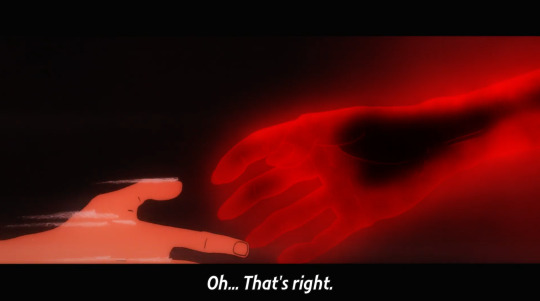


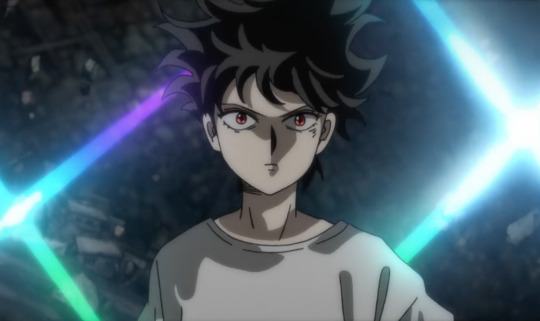
I think the key is that Shigeo initiated this change in himself in order to save someone. The Mogami arc, to me, is the key to the entire series: it's at this exact moment, when Mob makes the switch from "the world is so cruel... can I really do anything worthwhile" to "I'm here for a reason and my powers are here to let me help people". He's using his ability to harm, but in his service of other people and in the rejection of the bleak outlook Mogami offered. And it's being used in service of goodness that makes his power to harm, represented by the color red, beautiful. He clings to the idea that people can change, that bullies need not always be bullies, and he does not have to take revenge. His powers appear as vibrantly blue and pink as ever, and he expels all of Mogami's spirits from Minori's mind.
The show doesn't leave it at that, though. Mogami Arc is almost exactly halfway through Mob Psycho 100 for a reason: Mob has to grapple with his decision to accept the color red. He has to come to terms with his own ability to fight back, come to a nuanced understanding of his own decision-making process (when to fight, when to have mercy.)
Mogami shows up a second time in season two, episode eleven. He threatens to kill Minegishi (a man who was just trying to kill Mob), and Mob pleads for Minegishi's life. And the lighting in this scene is really interesting! Mob is in a blue shadow, the sun blocked out by Mogami's red miasma, until Mob states that he can't guarantee that anyone will choose to change, but he wants to give them a chance anyway, because you have to trust people to get anywhere. When Mob says that, Mogami fades away, letting the sunlight in.

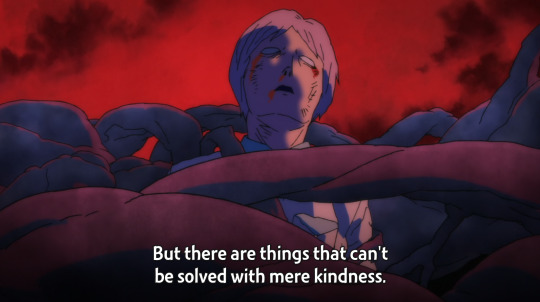
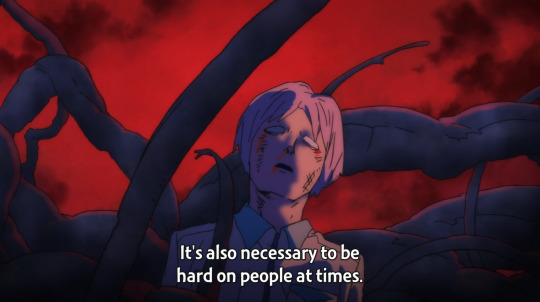
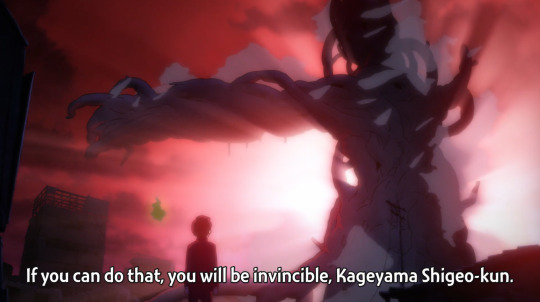
Also, this isn't about the color red, but I have to note that it is not an accident that Minori (who bullied Mob in Mogami's world, and who Mob chose to save), and Minegishi, both have this same light lavender hair color. They are parallels—both bullies, both having shown no sign that their apologies will be sincere and that they will change. And Mob chooses to give both of them another chance... although this second time, he takes it to heart that Mogami (Mogami-san, he calls him), told him that he has to be hard on people sometimes. Few people would know that Mob is capable of hurting others given the right circumstances more than Mogami does. And Mob respects Mogami, I think. He gives him the honorific -san, which is more than he does for Suzuki. I theorize that Mogami and Mob recognize each other as fellow sufferers from psychic powers. Fellow red-eyed (potential) monsters.
Shortly thereafter, Mob goes to fight Touichirou Suzuki. Suzuki is a red-coded character too. And although his red is more orange, less like Mob's blood red than Mogami's red is, he does resonate with Mob similarly. He brings out the worst in Mob: power-drunk ecstasy. Again, characters associated with red are associated with Mob's worst side, and they're typically the ones capable of bringing out his red side, not only because they force him into corners where he has no choice but to fight them with force but because they get him in a way that no one who doesn't share Mob's level of power really can.
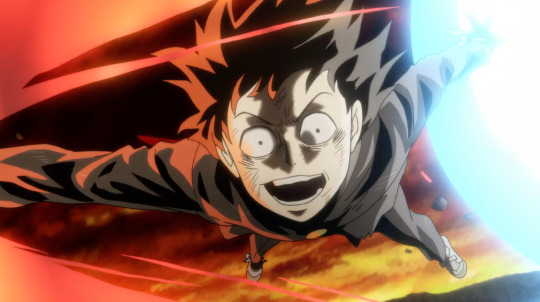

The thing that snaps Mob out of this haze is, fascinatingly, another person associated with red in Mob Psycho 100: Ritsu. Mob sees Ritsu on the ground, has a flashback to that traumatic memory with Ritsu bleeding, and stops laughing. He becomes mindful of his own choices again.

Mob's eyes remain black as he tries to reason with Touichirou. But when Mob gives up, acknowledging his own weakness, his inability to show Suzuki another path, his eyes turn red once again.
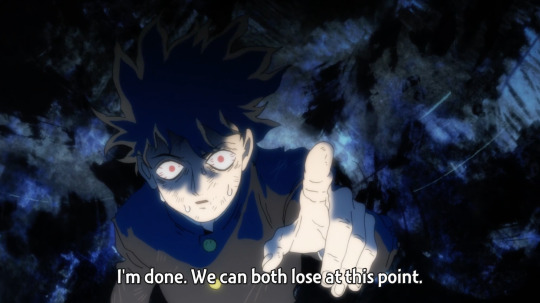
It's a horrible moment, the moment when Mob chooses to try to kill Suzuki instead of reasoning with him. Right after he makes this statement, he does something he's never done before: uses his psychic powers to directly alter someone's body. He has hit people with his powers before, but that was like a slap. What he does to Suzuki is something he learned from Mogami, who used his powers to twist Minori's finger joints until they cracked. Mob does the same thing to Suzuki, using his powers to twist Suzuki's body until his bones break. It's an exact parallel to what Mogami did. It's a tough call, figuring out what to think about this moment, but we're given clues to this moment both earlier and later. Mob cannot change everyone's mind, as Mogami said; Suzuki refused to listen and posed an active danger to Mob's little brother and friends, and Mob had no one to turn to for help here, so he chose to kill Suzuki.
Given Mob's pacifist outlook up to now, this was a huge change. He'd exorcised ghosts before, but he never killed a human being. But this was not the soul-destroying acceptance of revenge that turns the whole world red, like what almost happened in Mogami arc when Mob was about to accept Mogami's way of life. This was a one-time, no-win situation that Mob could not get out of. And because he'd been prepared for this by Mogami, and because he made the choice to use his powers instead of running away, his eyes turned red in determination. Again, it's about making a choice to use your power, not about the goodness of the choice. And you'll note that the red of his eyes here is flat and blank, like Mogami's eyes. Again with the subtlety. Red in mob psycho 100 has the common thematic thread of pain and power, but its meaning flexes based on context.
The significance of red has one more major comeback in MP100, and, fittingly, it's at the end of the series, where Mob's powers go out of control. Other people have spoken at length about the final arc of MP100, and it speaks for itself. But I have to briefly touch on this to bring this analysis to a conclusion—
Shigeo Kageyama's powers, walking a path of destruction through Seasoning City, is red, red, red. Red and black.

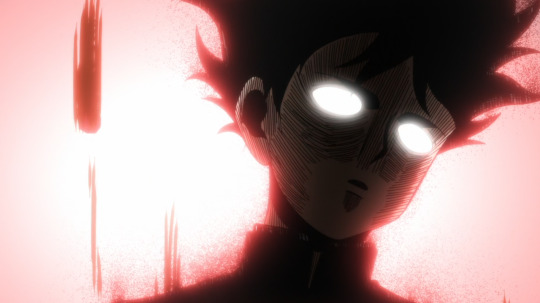
The red is a menacing color here. Although Mob's powers still come across in his bright, sparkling blue and pink, his body is surrounded in an intense blood red that gets stronger to the point of filling the background (in the style of Mogami's world). The red could be read as a symbol of evil, of malicious intent, like it was in Mogami's world. Except... Mob's eyes are the unconscious white of ???%, which represents Mob's fight or flight instinct and all of the things he represses because they are unsightly. Things he doesn't actually want to do consciously. Mob is doing this by accident, although as a natural consequence of what he has done to himself. Ritsu puts it well when he's talking to himself about how Mob locked away his emotions and powers:

This other side of Mob represents everything Mob fears about himself (power, rage, destructiveness conscious and unconscious.) But fearing Mob's other half does no good. For better or for worse, it is part of Mob.
In this instance, I think the significance of the color red lies in its association with fear. People are scared of things that can hurt them. Mob, specifically, is afraid of the power that he has seen hurt people, from himself hurting Ritsu to Mogami and Minori hurting Mob to Touichirou Suzuki hurting everyone.
The red, here, is a warning sign. It says get away from me before I hurt you. It's what Mob tries to prevent people from seeing. And it does represent malicious intent, but it also represents self-hate. It's everything Mob has fought over the course of the series, only it's also Mob himself.
But. But. Red is the color, consistently, of accepting and using your power. It's blood, sure, but it's also justice. It's rage, but it's also courage. It's determination. It's used in moments of wholeness of purpose—power and willpower agreed on a course of action. And in the end, Mob has to accept that his power is part of him, and it doesn't have to scare him. It doesn't have to be red suppressed within him (meaning blood, meaning Mogami, Suzuki); it can lie dormant when not needed but not repressed within him.
I don't have a good ending to this analysis. Just watch the series. It speaks for itself.
#this turned into an explanation of like. ALL of my thoughts about the Mogami arc. oops#mob psycho 100#mp100#mob-blogging#I thought about adding the parallel analysis of Dimple and his red cheeks to this post but I hit the limit on how many images you can add#alskdjflksdjflksdjflksdjf
123 notes
·
View notes
Text
Rick Prime's decoys
1. If Evil Morty knew for sure that the fingerguns would work on Rick Prime and he had the situation totally under control, wouldn't he have used them the first time he came within close proximity of Rick Prime?

You know. Instead of punching and kicking and getting strangled?
2. If he didn't know for sure whether the fingerguns would work on Rick Prime, was it because he made them with another Rick in mind, a Rick whose head was full of cables that could be overloaded by electricity...

(there is really no other way I can interpret his look except "uncertain")
Maybe he thought that, at worst, the fingerguns might temporarily incapacitate Prime, granting Eyepatch Morty a few more seconds, and at best, Rick Prime might have some sort of implant allowing them to work kinda as intended...
And work as intended they did...


(kinda similar, isn't it? Not the same, but similar.)
2. So, what, is Prime's head filled with puppeteering cables like Evil Rick's was?

Well, no.


And why should it be?
It shouldn't.
He works alone. He doesn't bother to team up with anyone, to manage people, or anything of the sort. He has said as much.

(headache? Interesting choice of words heh)
And yet, against the face of opposing evidence, I will continue talking :P
3. Because how do we explain THIS:

I've read a fan theory that Prime has time split himself (go read it!!!), and that's how he was able to be at several different places at once:

"I wish Morty. It's all the places he is."
And there could be a lot of truth in this theory, but it doesn't really explain why there would be a "main" Rick Prime.

If all copies of Rick Prime are the main one, and are just time shifted, then Rick C-137 would really have to kill all of them.
No, wait. Maybe killing the first (chronologically) Rick Prime would work as a domino effect and make all of them disappear via paradox??? (this might explain how Evil Morty seemed to be able to delete whole trees of Rick Prime clones at once)
Could be.
However, Prime being time shifted doesn't explain by itself how the copies were apparently able to communicate with each other. Finish each other's sentences.
They act like a collective, don't they?

Of course, you don't need mind control to explain that. It could just be a simple communication thing.
However, we've seen Rick C-137's decoys not only acting independently from each other, not only being unaware they're decoys and ignorant of each other's actions, not only being worried they might be fake, but trying their best to be the ones to come on top, the last ones to survive.

Compare this with Prime's decoys, which, despite Prime's massive ego, didn't even bat an eyelid at the prospect of being shot:

(I'm dead XD Look at his face)
So...
4. What if Prime was... mind controlling his own decoys? Puppeteering them, sorta?
Or maybe, if that was too much of a drag for his concentration, what if he let them act independently from him most of the time, overriding them only when the situation called for it?
Or maybe it was a time thing, and he used a puppeteering-ish/operation phoenix-ish implant to communicate his thoughts and transfer the consciousness? (but I still feel the various time split Rick Primes would try to fight each other... Time split Rick C-137 was quick to become paranoid and try to murder himself.)
Or it could be something entirely new, something that incudes all of the above at the same time. Maybe he did time shift himself and then merged his consciousness or something, to become one ultra person.
5. Anyway, the lack of visible cables (or any kind of implant on the head) could be explained by craftmanship more superior, discreet or compact than the one Evil Morty is using...
(and, interestingly, we never got to see what Rick Prime looked like at the very end... because Rick C-137 was blocking the view)

6. If this theory is true-ish, then this would be the understatement of the century...!

It's the least stealthy technique possible!!!
Prime would have at all times detailed information on exactly what Rick C-137 was doing, where he was, who was with him, and how far his search progressed.
This would be an extreme disadvantage for Rick C-137 I feel, which points away from this theory.
7. (Still going along with the theory anyway) Maybe THAT was the purpose of his Very Cool Chair: maybe the "main" Rick Prime (whatever that means) would sit there and control all his clones and decoys simultaneously, like a king on his throne:

Maybe all those thin black cables really were supposed to go to his head, but probably through a different piece of equipment or implant, and not through Eyepatch Morty's fingergun.
8. If this theory is true, it would be in line with the show's implied narrative that Rick Prime is the smartest, craftiest, strongest, most cunning Rick; he is the best in every aspect (except empathy lol), trading emotion and family and morals for... infinity. Greatness. Playing god.
His weapons are the deadliest, his teleportation goo the most versatile (it can take the form of living organisms!!), his creations the most elaborate, his messing with time the most advanced (he keeps himself youuuuuung)...
...So it would make sense that he has dabbled in brain control as well, reaching the point of simultaneously controlling hundreds of bodies at once.
54 notes
·
View notes
Photo

The Italian Renaissance: Culture and Society in Italy
Peter Burke’s "The Italian Renaissance" presents a cultural and sociological approach to understanding Renaissance Italy, arguing that the period cannot be fully grasped by focusing solely on the conscious intentions of artists or the genius of individuals. Instead, Burke emphasizes the broader cultural, regional, and social contexts that shaped the roles of artists, writers, and thinkers.
Peter Burke’s The Italian Renaissance offers a cultural and sociological analysis of Renaissance Italy, rejecting traditional narratives that focus solely on individual genius. Instead, Burke argues that artists and intellectuals must be understood in their social contexts. He insists that “we cannot understand the culture of Renaissance Italy if we look only at the conscious intentions of the artists, writers and performers,” since their work was shaped by institutions, expectations, and audiences (2).
Rather than presenting a chronological history, Burke emphasizes regional variation and the social structures that shaped artistic production. He analyzes a “creative elite” of roughly 600 figures—painters, sculptors, architects, writers, composers, and scientists—to identify patterns of cultural output, rather than isolated brilliance (3).
Burke challenges the notion of the Renaissance as a unified or self-conscious movement. Instead of vague claims about cultural “flourishing,” he calls for measurable evidence of innovation, such as new genres or stylistic shifts (15). While crediting Vasari with articulating a break from medieval art, Burke stresses that the Renaissance was not a rejection of the Middle Ages. Artists “borrowed from both traditions and followed neither completely” (19).
He critiques conventional labels like realism, secularism, and individualism, arguing that they often obscure historical realities. For example, “realism” is a 19th-century term that fails to capture the complexity of Renaissance representation. Rather than theorizing broadly, Burke grounds his analysis on specific practices—such as greater attention to nature and visual accuracy (19–20). Likewise, he contends that secularism and individualism, while emergent, were not dominant forces (23–25).
In his sociological study, Burke observes that most Renaissance artists came from artisan or merchant families, while writers and humanists were more often sons of professionals or nobles (44). Formal training—through workshops for visual artists or Latin schools for writers—played a decisive role. Talent alone was insufficient; access to education and opportunity were key. Interestingly, those who crossed class boundaries, such as artisans’ sons who became scholars, were often the most innovative figures (51).
Regional differences also mattered. Tuscany, the Veneto, and Lombardy produced more visual artists, while literary innovation was concentrated in Genoa and Naples (44). Florence’s openness to outsiders may explain its unusual cultural dynamism, in contrast to the more rigid systems of Venice (67–68).
Patronage was central to artistic life. While long-term patrons offered stability, they often restricted creative freedom. By contrast, individual commissions allowed more experimentation. Burke finds that republican city-states like Florence and Venice, rather than princely courts, were the principal sites of innovation (94). Over time, artists gained more autonomy, as their expertise was increasingly respected and their social status improved (100–22).
Art in the Renaissance served diverse purposes—religious, political, and aesthetic. Many works were devotional, others expressed civic pride, and some simply offered pleasure to elite audiences. Burke traces changes in taste, from simplicity to complexity and from nature to fantasy, always reflecting larger cultural shifts (152–58). He notes that taste was not monolithic; it varied by region, class, and level of education (158).
In later chapters, Burke explores how Renaissance worldviews reflected broader mental structures. He argues that Renaissance Italians lived in an “animate” universe organized by symbolic associations and moral hierarchies—not the mechanistic world of modern science (177–201). Cities like Florence, marked by commerce and competition, provided ideal environments for innovation (220).
Ultimately, Burke argues that Renaissance ideals spread unevenly across Europe, taking root in places with similar urban, commercial, and intellectual characteristics. As Italy’s economic and political power declined, other regions became new centers of cultural innovation (244).
Read More
⇒ The Italian Renaissance: Culture and Society in Italy
22 notes
·
View notes